





IRusty Goebel
Ohio Soybean Association President Williams County soybean farmer







IRusty Goebel
Ohio Soybean Association President Williams County soybean farmer
always enjoy a farmer meeting — getting to talk with fellow farmers I haven’t seen in a while, hearing the latest updates on our industry and, of course, all the baseball hats that we can add to our collections.
As I write this column, we are in the midst of our second year of the Ohio Soybean Association (OSA) Hometown Tour. We started the tour last year as a way to meet farmers where they live and engage them on the biggest issues facing our industry, including policy issues in Columbus and Washington, D.C.
I got to attend one of our stops at Bridgewater Dairy in Montpelier, which is not far from my own Williams County farm. One thing that stood out to me was how engaged our farmer audience was during the policy roundtable we had with State Representative Jim Hoops. We covered several big topics: H2Ohio, farmland preservation, and the upcoming election.
Beyond getting to talk about important policy issues that we’ve been working on at OSA, I was so happy to see all of those farmers directly interacting with their Ohio House representative. It reminded me of how powerful farmers are as a collective — how important, powerful, and influential our voice can be when we show up and work together, often in the face of people who discount us.
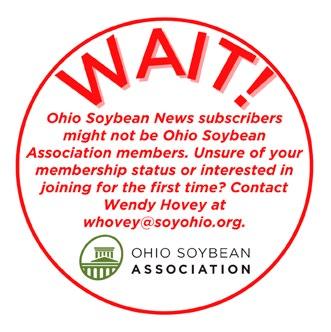
If you are ready to make a difference on behalf of your fellow farmers and our industry, I implore you to sign up for an OSA membership. We’ll be running our annual Farm Science Review membership discount — 10 percent off one- and three-year memberships. If you’ll be there, stop by our booth (#441) at the corner of Friday Avenue and Tractor Street. If you won’t be at FSR, you can always sign up at www.soyohio.org/membership.
Wishing you all a safe and plentiful harvest!
Rusty Goebel
President
Rusty Goebel, Williams County
Vice President
Bennett Musselman, Pickaway County
Treasurer
Trish Cunningham, Union County
Secretary
Jeff Magyar, Ashtabula County
Chairman
Patrick Knouff, Shelby County
Trustees
David Clark, Warren County
Dustin Converse, Union County
Dave Green, Crawford County
Austin Heil, Hardin County
Scott Metzger, Ross County
Jeremy Price, Putnam County
Derek Reusser, Wayne County
Ryan Rhoades, Marion County
Andy Stickel, Wood County
Bob Suver, Clark County
Kerrick Wilson, Preble County
Jennifer Wilson-Oechsle, Van Wert County
American Soybean Association
Board Representatives
Rusty Goebel
Scott Metzger
Ryan Rhoades
Staff Credits
Kirk Merritt - Publisher
Julia Brown - Editor
Mackenzie Joseph - Staff Writer
Brent Warren - Art Director
Barry Falkner - Photo Quality/Proofer
Ohio Soybean News is published six times a year by the Ohio Soybean Association, 918 Proprietors Rd., Suite A, Worthington, OH 43085. Phone: 614-476-3100.
Comments and statewide news articles should be sent to the above address. Advertising space reservation must be made by the first of the month preceding publication. In consideration of the acceptance of advertisement, the agency and the advertiser must, in respect of the contents of the advertisement, indemnify and save the publisher harmless against any expense arising from claims or actions against the publisher because of the publication of the content of the advertisement.
For Advertising Sales Contact:
Matt Herman - (612) 812-5833 matt.herman@dtn.com
For Address Corrections Contact: Ohio Soybean News at 918 Proprietors Rd., Suite A, Worthington, OH 43085.
Web address: www.soyohio.org
E-mail: cdeboard@soyohio.org
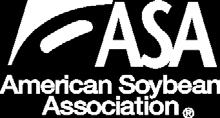


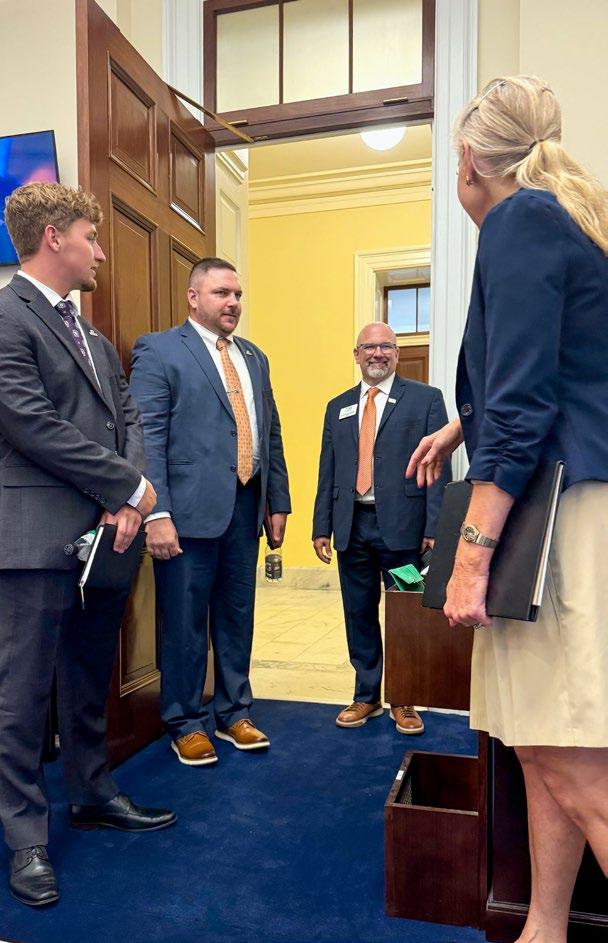
In July, the Ohio Soybean Association (OSA) conducted an advocacy trip to Washington, D.C., focusing on key agricultural issues, including the Farm Bill, the biofuels industry, and crop protection.
OSA board members and staff engaged with lawmakers on Capitol Hill, including representatives from the offices of Rep. Mike Carey (R-15th), Rep. Troy Balderson (R12th), Rep. Michael Rulli (R-6th), Rep. Max Miller (R-7th), Rep. Marcy Kaptur (D-9th), and Senator Sherrod Brown (D-Ohio).
One of the most crucial issues discussed was urging the timely passage of a new Farm Bill by the end of the year. OSA board members emphasized the bill’s necessity to address the challenges of falling crop prices, high production costs, and rising interest rates. OSA joined over 500 organizations in advocating for the bill, stressing that an extension
of the current legislation would be insufficient in the current economic climate.
During the trip, OSA also supported efforts to limit federal subsidies for biofuels made from imported foreign feedstocks. The association backed the call for the 45Z Clean Fuel Production Credit to prioritize biofuels derived from domestic sources, like soy oil, to benefit U.S. farmers.
Additionally, OSA joined national agriculture groups in addressing concerns with the U.S. Environmental Protection Agency (EPA) regarding its process for assessing pesticide risks to endangered species. OSA argued that the EPA’s current methods are overly conservative and often based on unrefined models, leading to exaggerated risk assessments. These assessments could result in unnecessarily stringent and costly restrictions for farmers. OSA advocated for a more balanced approach that incorporates relevant scientific and commercial data to protect both species and the farming industry.
Ohio farmer attendees also participated in a Soy Issues and Policy Forum hosted by the American Soybean Association as part of the trip. Overall, the trip provided a crucial platform for Ohio farmer leaders to effectively address their concerns and express support on the vital issues currently facing the soybean industry. u
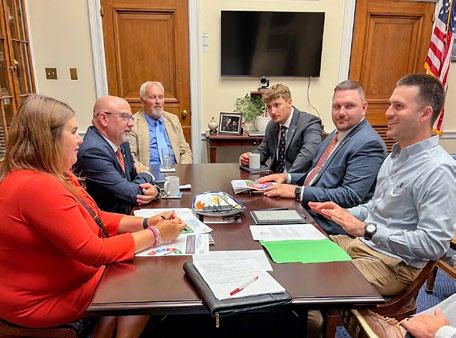

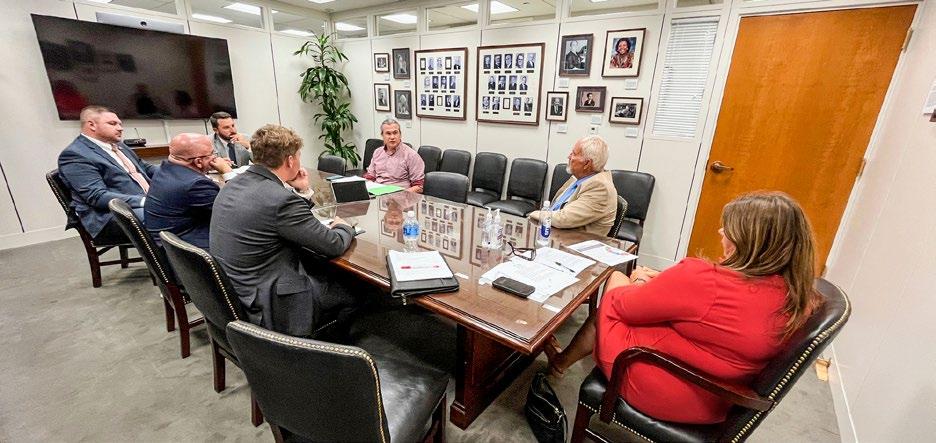


The Ohio Soybean Council wants growers to stay on top of the most recent agronomic discoveries. That’s why your soybean checko developed Field Leader, an online resource to give you access to the latest soybean research.
Find all the ways the Ohio Soybean Council and soybean checko work for you by clicking the “Ohio Field Leader” tab at OCJ.com.



to you
Every operation has a story. As a farmer-owned lending cooperative, Farm Credit Mid-America is proud to play a role in it – with loans* built for farmers, programs like Growing Forward® that help beginning farmers, and by returning a portion of our profits to our customers in the form of patronage**.
This August, the Ohio Soybean Association (OSA) continued its Ohio Soybean Hometown Tour, bringing its work directly to farmers through regional meetings across Ohio. In its second year, the tour featured four events between July 30 and August 14, with stops at Cargill in Sidney, Airable Research Lab in Delaware, Bridgewater Dairy in Montpelier, and Beck’s Hybrids in London.
After months of planning, farmers were treated to breakfast and discussions around OSA’s policy work, as well as new innovations and research. From presentations to field demonstrations, these events provided farmers with insights into practices and technologies that are directly applicable in the field.
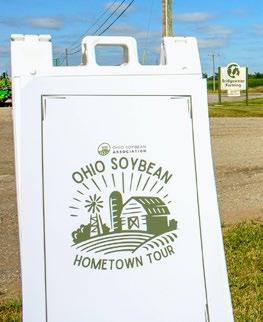
The tour began on July 30 at Cargill in Sidney, where participants attended presentations on soybean yields, the agricultural economy and an update on the biofuels market. This was followed by a policy roundtable with State Representative Susan Manchester. Participants were also treated to a behind-the-scenes look at the Cargill crush facility.
The next stop on August 6 at Airable Research Lab in Delaware followed a similar format, with discussions on accelerating soybean yields, economic updates, and discussions on the latest ag policies. The event concluded with insights into farm research, a grain market update and a tour of the Airable research
lab, highlighting new products that utilize soy-based feedstocks to solve industrial and consumer challenges.
The very next day, on August 7, the Hometown Tour headed up to Bridgewater Dairy in Montpelier.
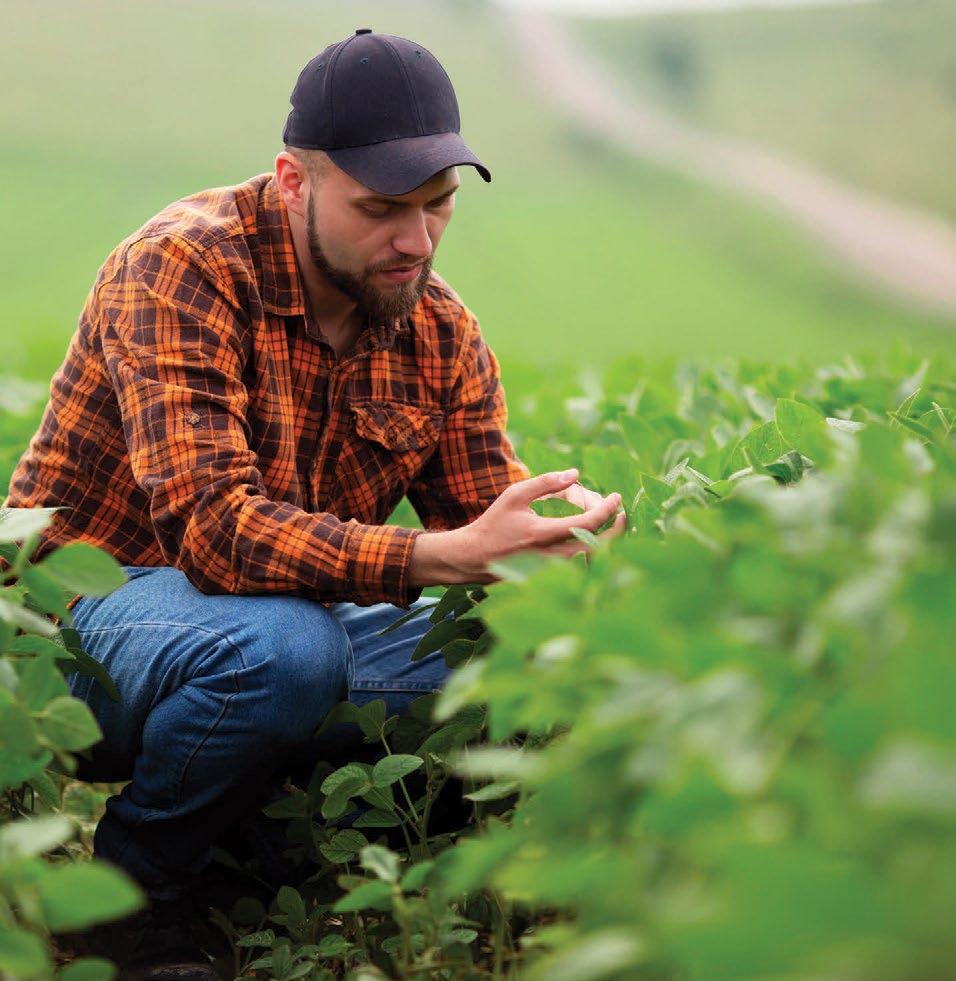

The day featured presentations on soybean yield advancements, an economic update, a policy roundtable with State Rep. James Hoops, and a grain market discussion, ending with an exclusive tour of Bridgewater Dairy.
The final event on August 14 at Beck’s Hybrids in London included a jam-packed agenda with presentations on soybean yields and economic outlooks, and a policy roundtable with Ohio Department of Agriculture Director Brian Baldridge. Attendees were also treated to an autonomous technology
demonstration by Dr. Scott Shearer from The Ohio State University.
The day wrapped up with a grain market update and a tour of Beck’s Hybrids’ test plots.
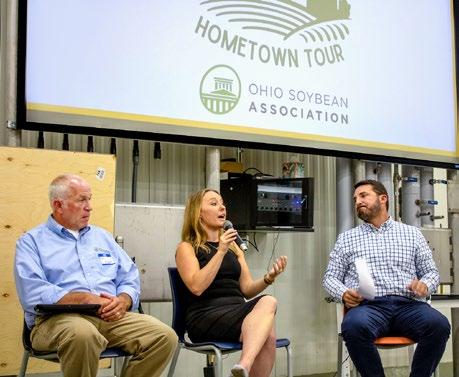
OSA thanks all attendees, sponsors, and hosts for making the tour a success. Stay tuned for upcoming Hometown Tours by visiting SoyOhio.org/Hometown u
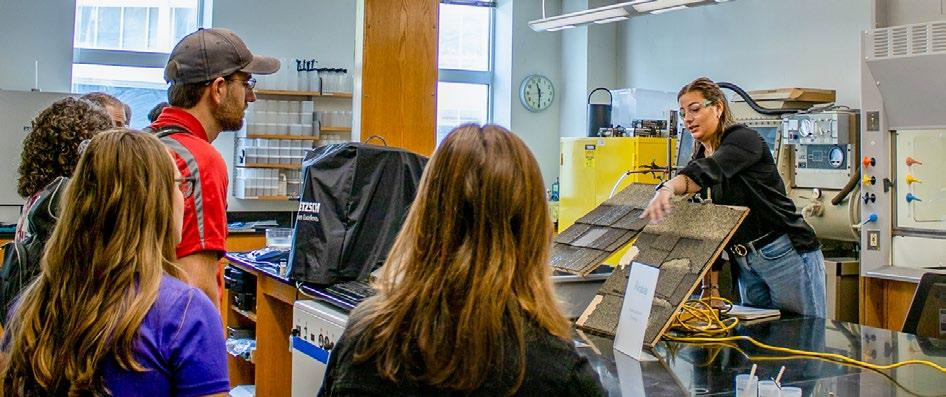





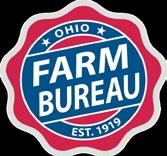


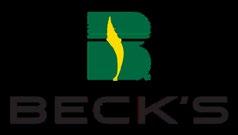







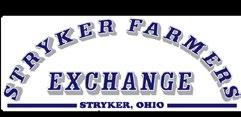







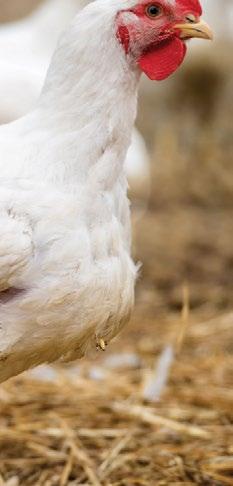





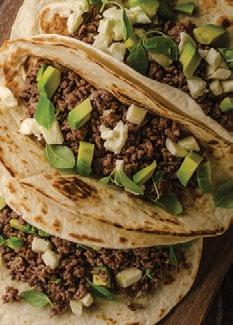







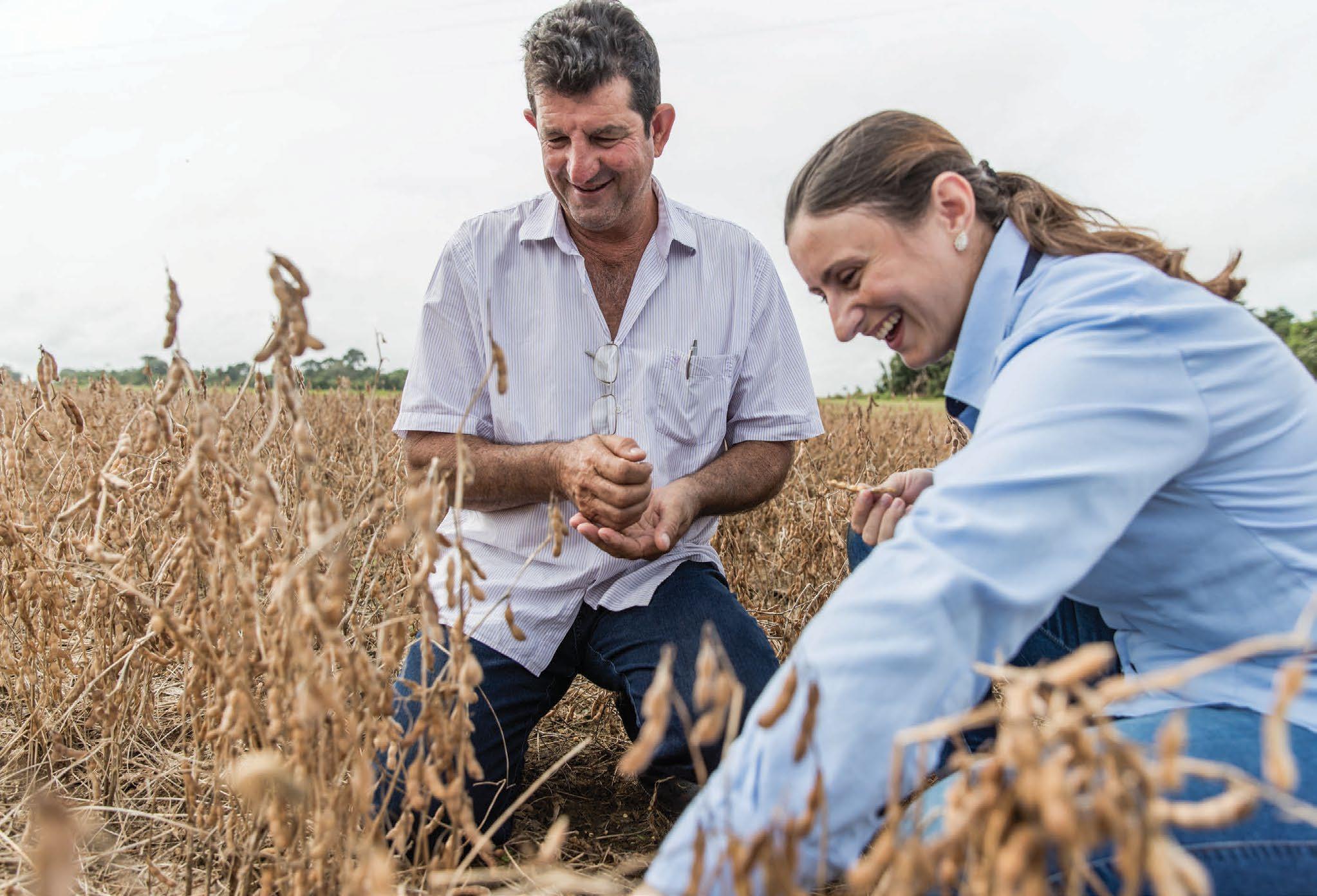
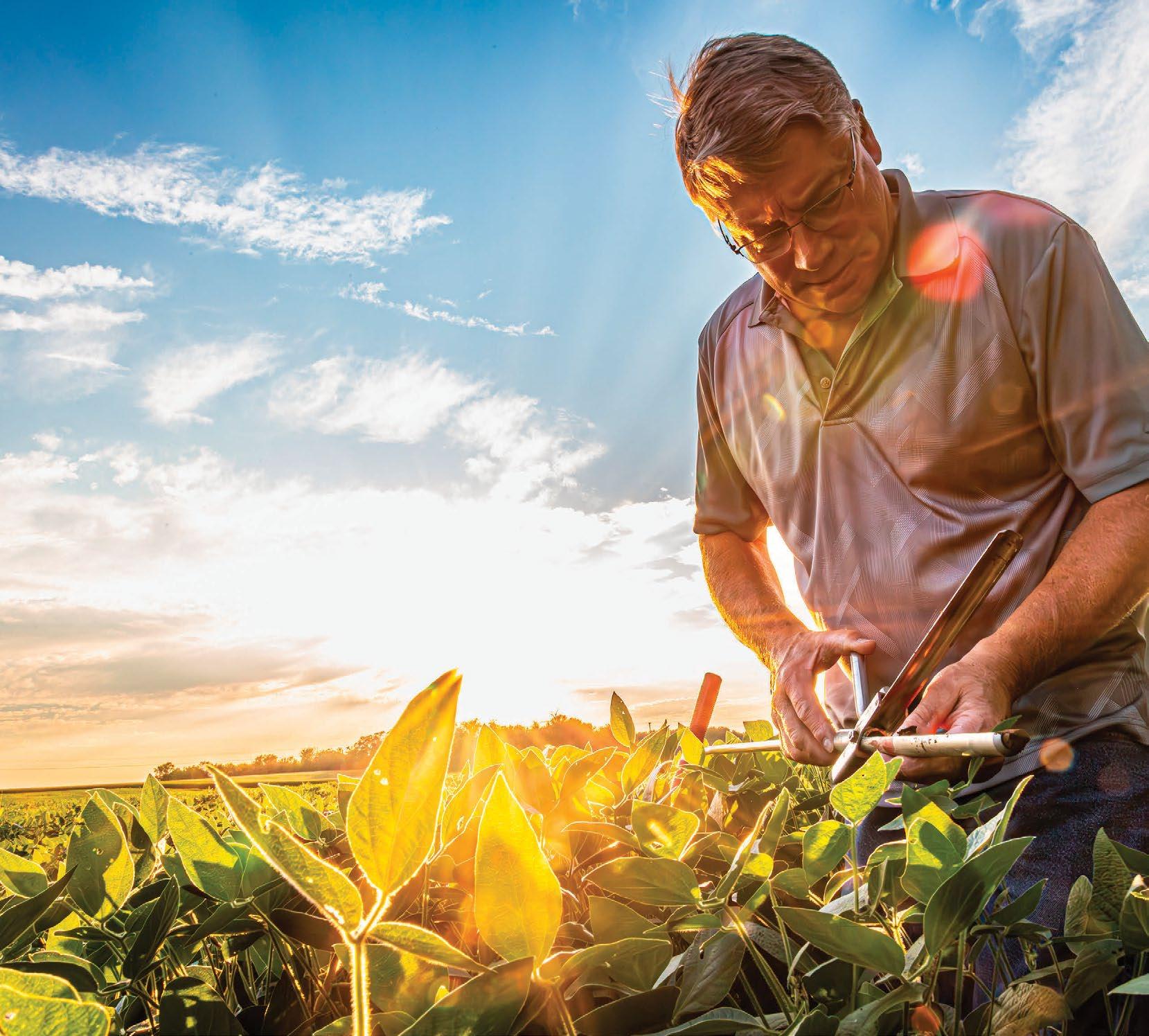


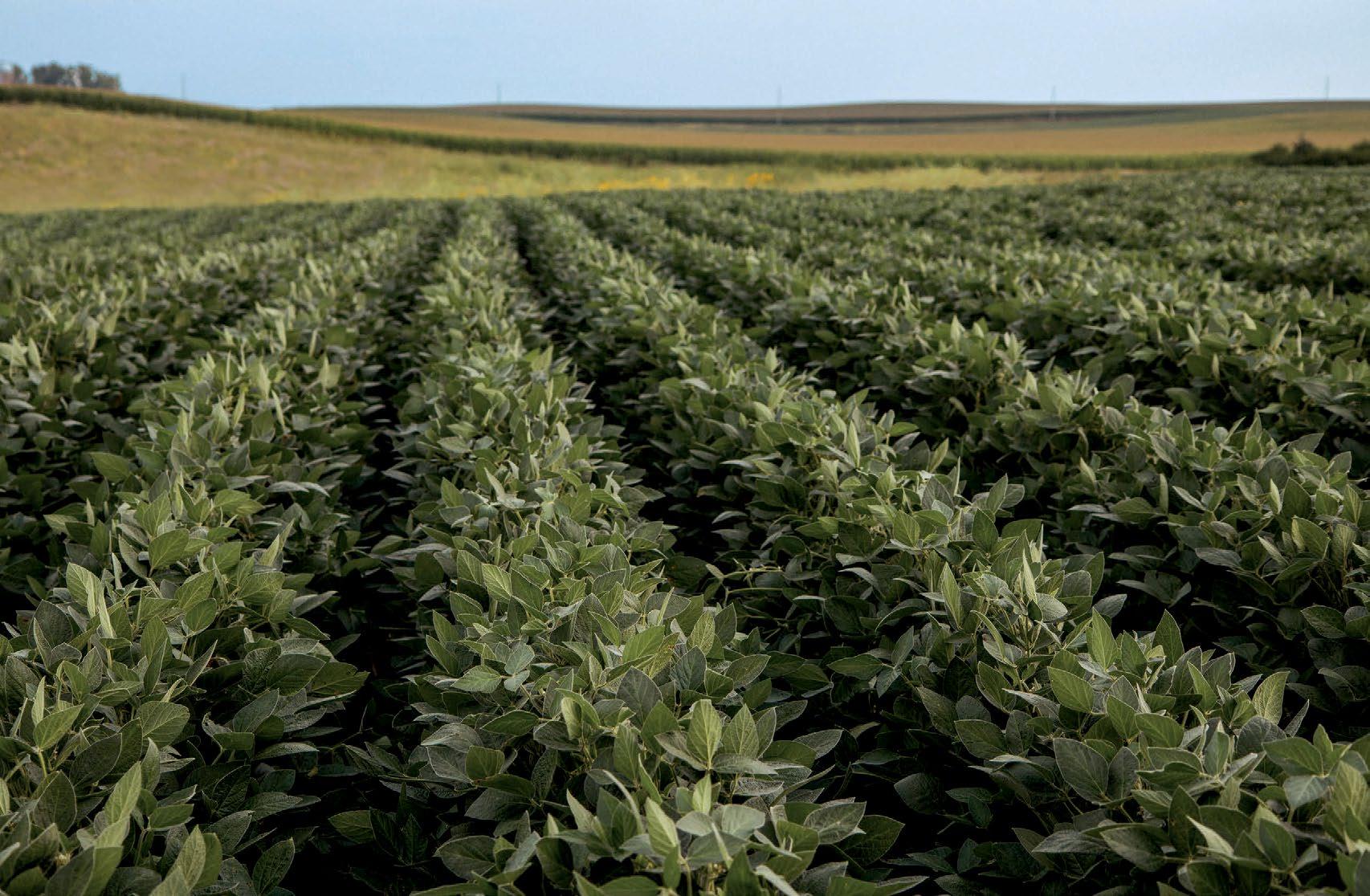
SIMPLE
. Enlist E3 ® soybean varieties from Seed Consultants feature outstanding agronomic improvements over established lines and are specifically developed to excel in the unique soils and conditions of the eastern Corn Belt. Let our elite Enlist E3 varieties and agronomic support simplify your soybean production this year.
Contact your local Seed Consultants sales professional or visit SeedConsultants.com
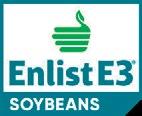


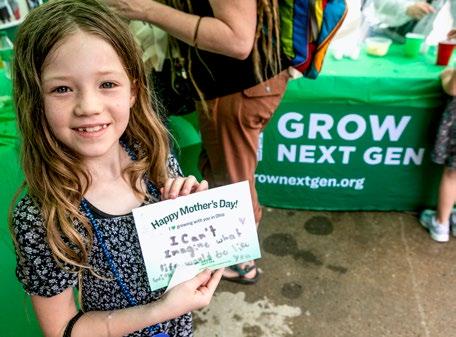
This year, the GrowNextGen (GNG) Ambassador Program, supported by the Ohio Soybean Council, has been busy introducing Ohioans to the world of soybeans and modern agriculture. Five college students — Kaylynn Wilhelm, Faith Galavich, Makayla Spoerr, Lena Dickerson and Koren Truance — have been crisscrossing the state, sharing their knowledge at events ranging from county fairs to science festivals.
“Education is the backbone of agriculture,” says Kaylynn Wilhelm, a sophomore at The Ohio State University. Her background uniquely positions her for this role: “My mom is a teacher and my dad is a soybean farmer, so it came together where I can be a farmer and educator at the same time.”
The Ohio State Fair was a highlight of the program’s outreach efforts. At their booth in the Voinovich Livestock & Trade Center, ambassadors engaged visitors with
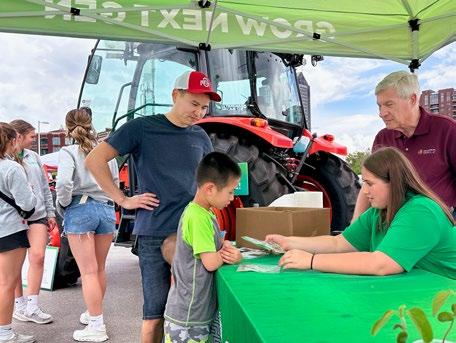
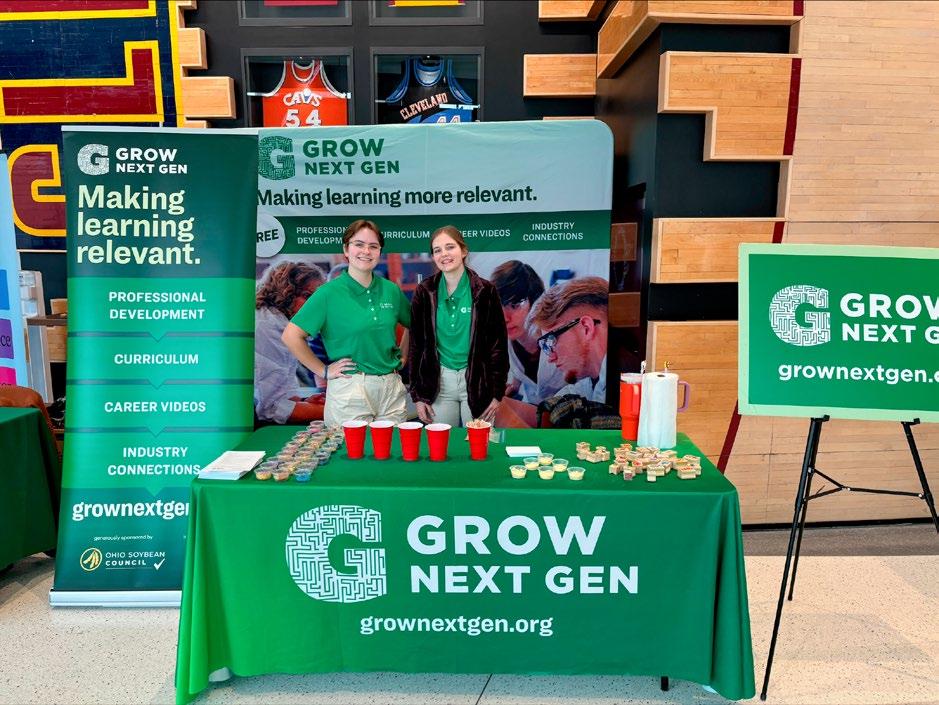
surprising facts about soybeans. “We talk about how our food is similar to livestock feed with the use of soybeans in both,” explained Makayla Spoerr, a student at The Ohio State University Agricultural Technical Institute. “A lot of people don’t realize that nearly every packaged human food product contains some form of soy.”
Spoerr and her fellow ambassadors pointed out familiar snacks like Cheez-Its, Chex Mix and Skittles, all of which contain soybean ingredients. This connection between
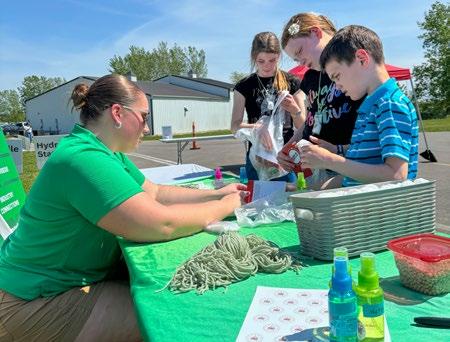
everyday foods and agriculture was eye-opening for many fairgoers.
Beyond the state fair, GNG Ambassadors have been active at numerous events across Ohio. At the COSI Science Fest in Columbus, they engaged over 1,600 participants with hands-on activities. Lena Dickerson, an Otterbein University student, highlighted the popularity of their soybean seed necklaces: “All you have to do is put two tiny soybeans in a packet with a cotton ball and spray it a bit with water. As long as you’re wearing it around your neck, the
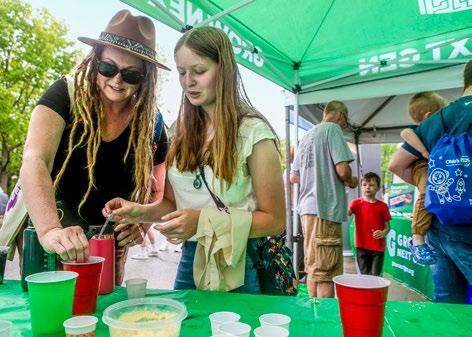

heat from your body actually helps it germinate and grow.”
Dickerson, who didn’t have much experience with soybeans before coming to Ohio, now recognizes their importance: “Now I see that they’re the backbone of Ohio’s economy. They impact all of life.” She added, “The necklaces show how important soybeans are to the economy because of how fast they grow.”
At the Ohio FFA State Convention and Wood County Ag Day, students
and Athens, the ambassadors have brought agricultural education to diverse communities across Ohio.
Wilhelm sees the program as a bridge between urban and rural areas. “I grew up participating in 4-H and FFA. Watching my dad farm, I noticed that not everyone has had that experience, and I am privileged to have had it,” she reflected. “It’s really important that we plant seeds of not only soybeans but also science and agriculture as soon as possible.”
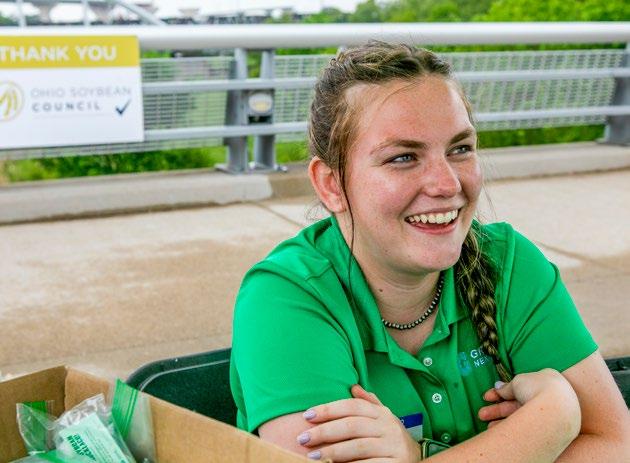
explored topics such as the use of drones in agriculture and the impact of tire size on soil compaction. These demonstrations made agricultural science accessible and engaging for students considering future careers in the field.
The program’s reach has already been substantial this year — with over 10,000 youth and community members engaged. From STEM days with the Cleveland Cavaliers and Guardians to agricultural days in counties like Gallia, Meigs
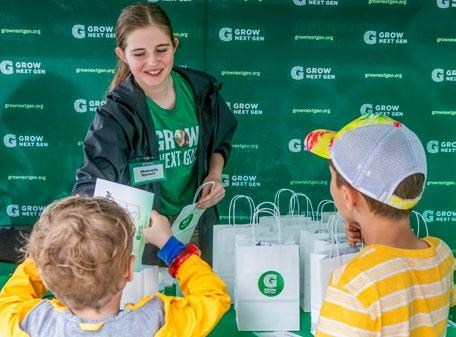
The ambassadors’ enthusiasm extends to all aspects of their work. After a recent event at Waterman Agricultural and Natural Resources Laboratory, Dickerson shared, “We had an absolute blast teaching kids about water testing, GMOs, and water molecules. I think my favorite part of the event was visiting the apple orchard with all of the groups, where we learned that each of the apple trees had been grafted together from two separate species to get the best characteristics from each other!”
The impact of the GNG Ambassador Program extends beyond immediate interactions. Micah Mensing, a program alumnus
now working in farm finance, attests to its lasting benefits: “They taught me to take complex ideas like turning a soybean into biofuel, break them down and explain them to anybody. I use this skill in my career every day.”
As the program continues to grow, it’s clear that these young ambassadors are doing more than just educating — they’re cultivating a future where Ohioans have a deeper understanding and appreciation for the role of soybeans and agriculture in their daily lives. Through their efforts, the next generation is learning about the science behind their food and the innovative practices that keep Ohio’s farms sustainable and productive.
Dickerson summed up the program’s impact: “GrowNextGen is doing great things with the Ohio Soybean Council to educate people, especially kids, about agriculture.”
The Ohio Soybean Council’s investment in this program demonstrates the importance of connecting consumers with agriculture. As these ambassadors continue their work, they’re not just talking about soybeans — they’re planting seeds of knowledge that will yield a more informed and engaged Ohio for years to come. u
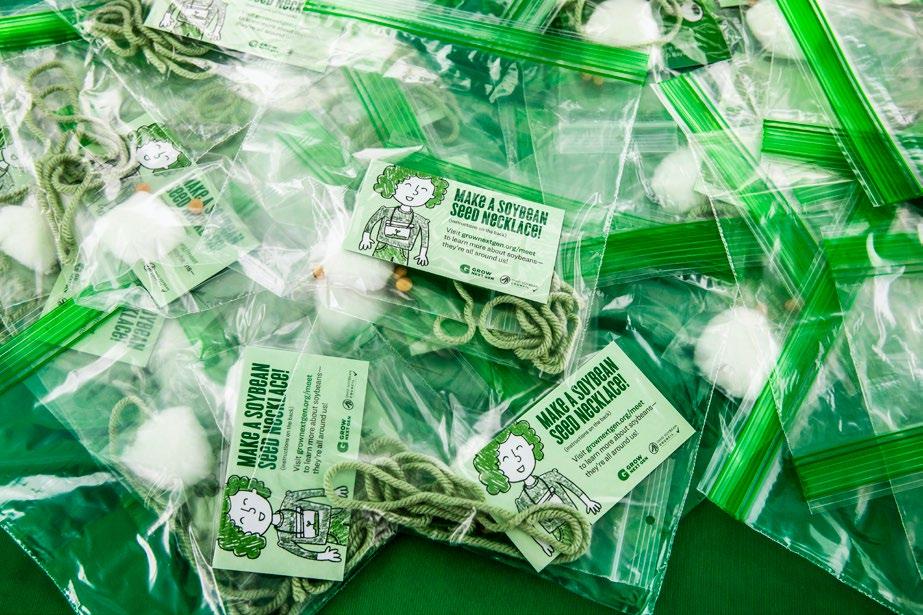
To a farmer, it’s not secret how important soybeans are. But how do you make soybeans meaningful to the average consumer? The Ohio Soybean Council and soybean checkoff are on a mission to help consumers better understand the potential of Ohio-grown soybeans.
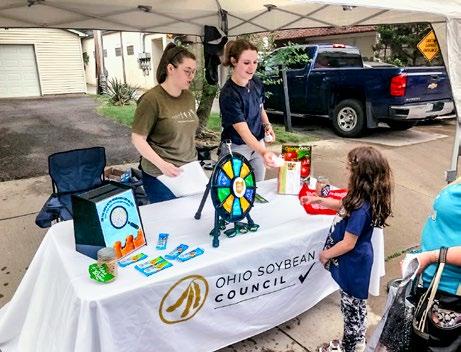
Farmers markets are usually made up of farmers selling their produce, meat and dairy products. But what about row crops?
Each summer, the Ohio Soybean Council has a booth at three farmers markets around Columbus in Bexley, Clintonville and Upper Arlington. The markets provide the chance to talk to hundreds of urban and suburban consumers each month about modern farming. OSC staff members field questions about what soybeans are used for, how they are grown, and why GMOs are important.
Launched last year, the Soy Has A Secret campaign aims to educate consumers about the many uses of soy. Most people can recognize soy as an ingredient on their plate, but not everyone knows the many uses of soybeans in everyday products.
Starting this fall, the campaign will begin to highlight soybased products developed by
the checkoff, including DEWALT’s Biodegradable Bar & Chain Oil, Sofia’s Soy Cleaner and SoyFoam, a firefighting foam made from soybean meal.
The campaign has also been featured in other collaborations with The Ohio State University and the Ohio High School Athletics Association to help amplify the message to a broader audience. For those partnerships, soy-backed turf and soy protein were highlighted as ways young athletes might engage with soy every day without knowing it.
Last fall, Soy Has A Secret ads on Hulu, Spotify and Facebook/ Instagram reached nearly 2 million consumers around Ohio. See the rest of the Soy Has A Secret campaign at www.soysecrets.org
Meet Zoe Kent

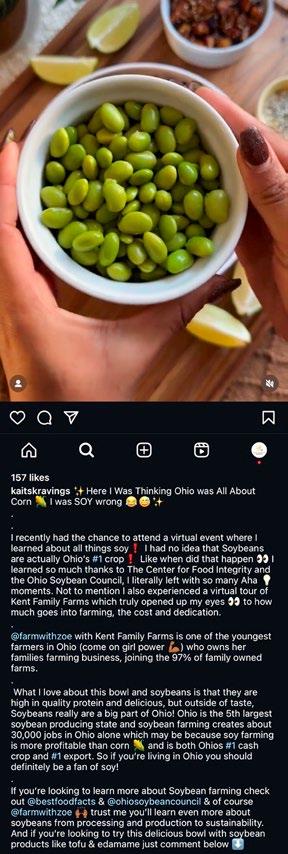
— a young, futurefocused Crawford County corn and soybean farmer whose father turned over the reins of the family farm to her in late 2021. Armed with a degree in agri-business from The Ohio State University and a long-time passion for growing food, Zoe incorporates practices and technology to produce food more sustainably.
Three online influencers met Zoe to learn more about her approach in a virtual tour that showcased Zoe’s family and farm history, and ways she and a small team of employees (Dad included) grow crops with an eye toward protecting our environment.
Jenny Zaerr of @jennysbitesnbooze had this to say about her experience on the virtual tour:
“Hearing from a farmer directly opened my eyes to all the work that goes into foods and products that we consume and use regularly, yet we rarely think about the origin or back story or all the labor that is involved. It really inspired me to become more educated on how our food is produced and processed, and to always support local if, when and where possible! The large majority of farmers are family-owned and not big corporations.”
The full virtual tour can be found on www.bestfoodfacts.org. u
with ExPress ® Soy Meal
INCREASED DIGESTIBILITY FOR DECREASED DIET COSTS
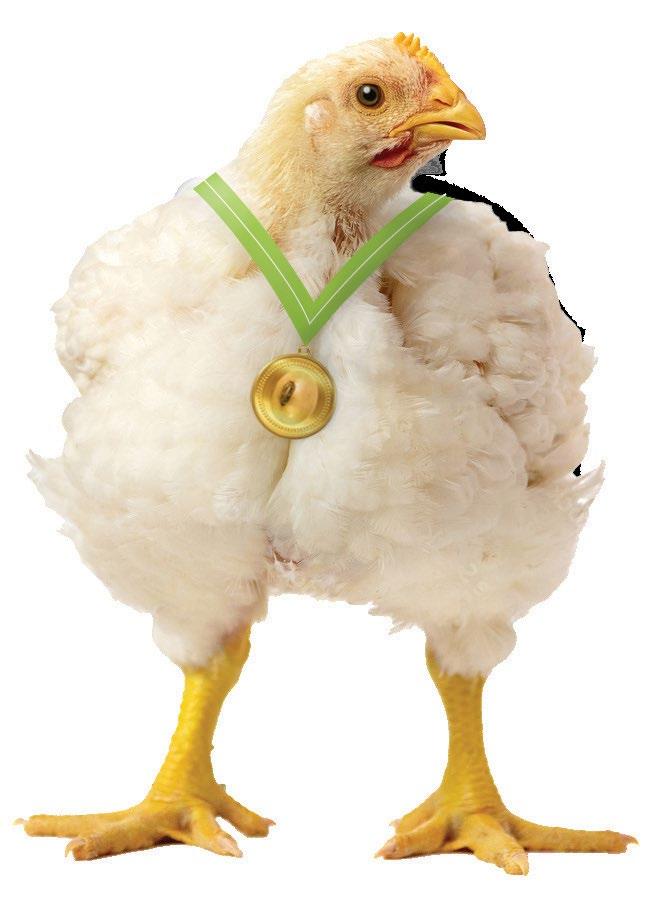
Reach broiler weight 2 days faster when using ExPress® soymeal in diets.
Feed swine 24.4 lbs less feed when using ExPress®

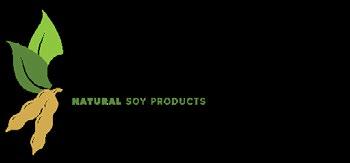


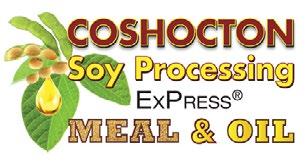



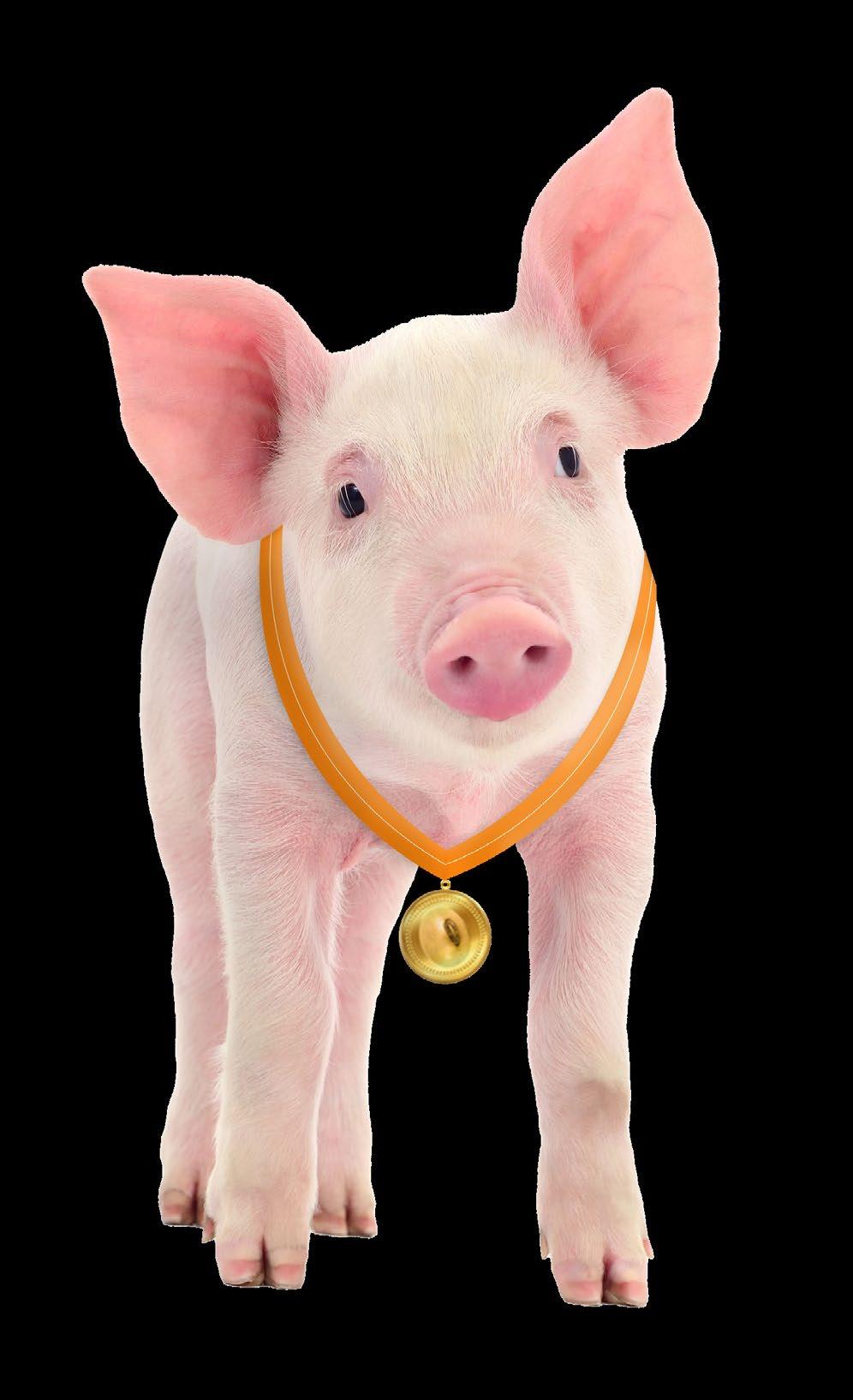
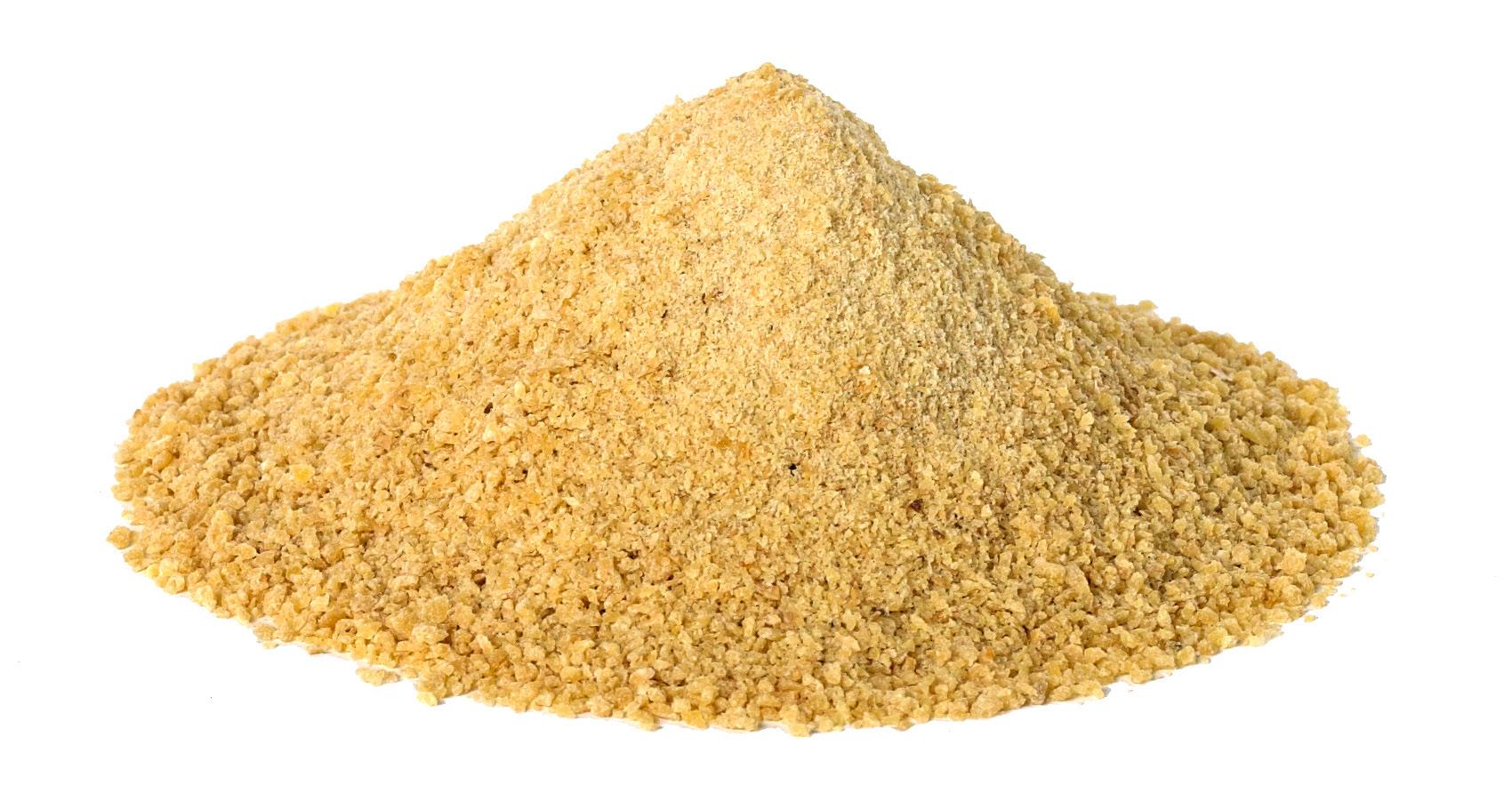
Darke County farmer and Ohio Soybean Council (OSC) board member Chad Warner traveled to Korea from June 18–24, 2024, to participate in the Sustainable U.S. Soy Conference and “Soy Day” Awards. During his visit, Warner represented OSC at various U.S. Soybean Export Council (USSEC) events, participated in a farmer panel on specialty soybeans and presented awards to graduates of the Korea Soy Food Masters Program, which is funded by the Ohio Soybean Council.
USSEC offers ongoing education through programs like the Soy Excellence Centers, Soybean Oil Masters (sponsored by The Indiana Soybean Alliance), Soy Food Masters, and the Soy Innovation Center. These initiatives, including the Sustainable U.S. Soy Conference and Soy Masters programs, play a significant role in promoting U.S.-grown soybeans globally.
Originally launched in Japan, the Soybean Oil Masters program has expanded to China, Korea, Taiwan, Southeast Asia and the Americas. The program aims to enhance the global image of U.S. soybean oil by educating participants on the entire value chain, from farm to end product.
“Our ‘Masters’ programs not only build relationships with customers but also raise awareness of the benefits of U.S. Soy among key influencers,” says Will McNair, director of oil and soy foods for USSEC. “This intensive education naturally turns participants into brand ambassadors.”
The Soybean Oil Masters program targets participants from all segments of the value chain, ensuring they gain a comprehensive understanding of the entire process. “The courses highlight
the advantages of U.S. soybean oil, covering everything from nutrition and culinary use to practical aspects like oxidization, fry life and sustainability,” McNair adds.
Similarly, in Korea, the Soy Food Masters program is dedicated to boosting the use of soy foods like tofu, soy sauce and soy milk in the hotel, restaurant and institutional (HRI) sectors, as well as the home meal replacement (HMR) market. “USSEC also conducts soy food cooking classes to promote soy foods in the food service industry,” McNair says. “Involving dieticians in HRI and HMR sectors helps them learn the value of soy foods made from U.S. soy for group meals.”
Successful completion of the online course and a passing grade on the exam earn participants the title of “Soy Food Masters.” This is the Ohio Soybean Council’s third year supporting the Soy Food Masters program. Since 2022, over 200 participants have completed the program, with some graduates visiting Ohio in September 2023 to deepen their understanding of specialty-grown beans. Another visit is expected this September.
Reflecting on the event, Chad Warner shared, “I was very proud to
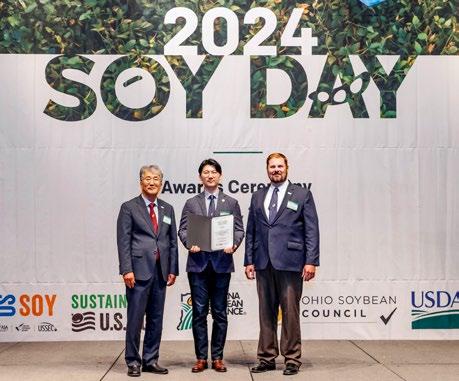
be one of the farmers to present certificates at the USSEC Soy Day event. This event wraps up a yearlong program that showcases innovative ways to incorporate U.S. soy into meals. As a farmer who grows for the specialty soybean market and serves on the Council board, it was great to see the strong interest from those involved in this OSC-funded program. It’s a fantastic way to build global connections and highlight the quality of U.S. and Ohio soybeans, helping to create lasting partnerships for farmers and international consumers.” u
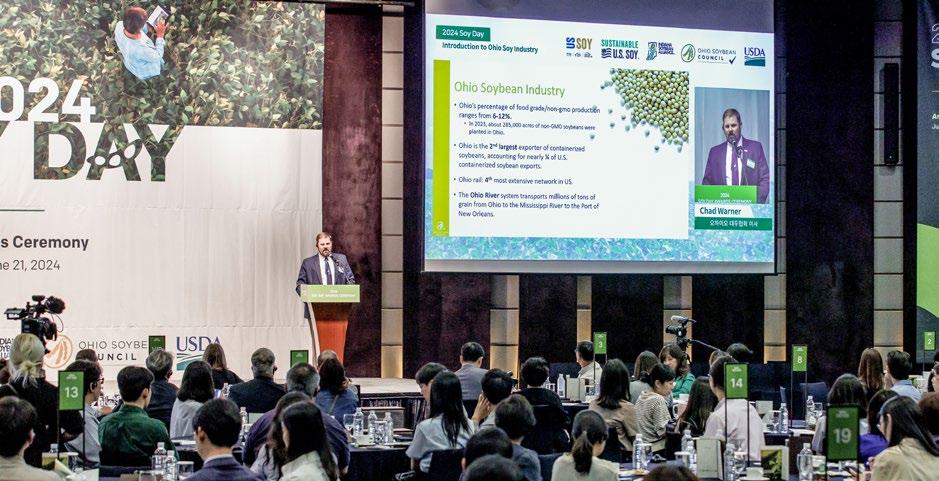



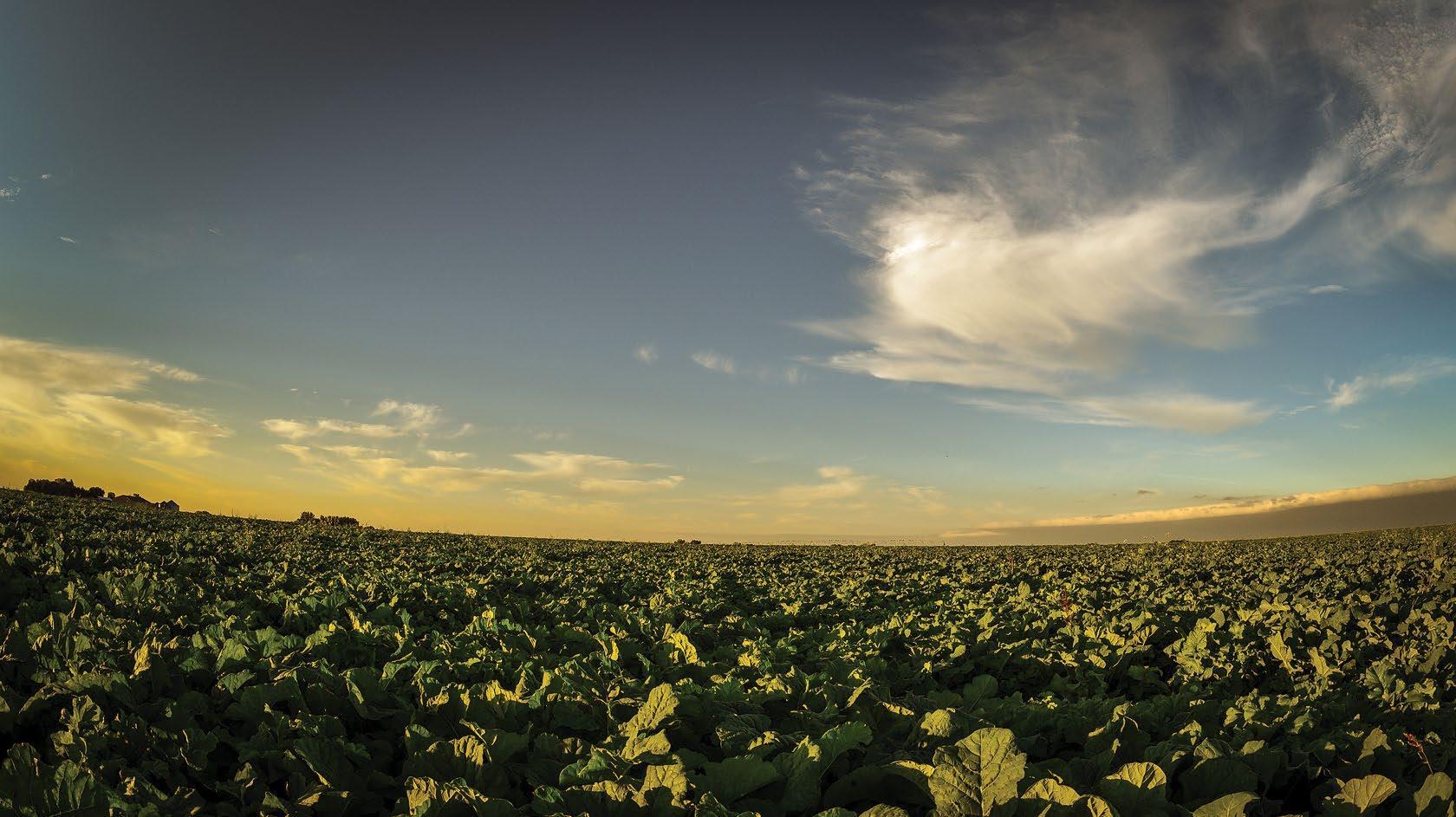
To help cover the start-up costs of cover crops, Farmers for Soil Health o ers financial assistance of up to $50/acre over a three-year period.
Enrollment in Farmers for Soil Health provides access to an exclusive future marketplace connecting farmers to top-tier supply chain partners that are focused on sustainability.
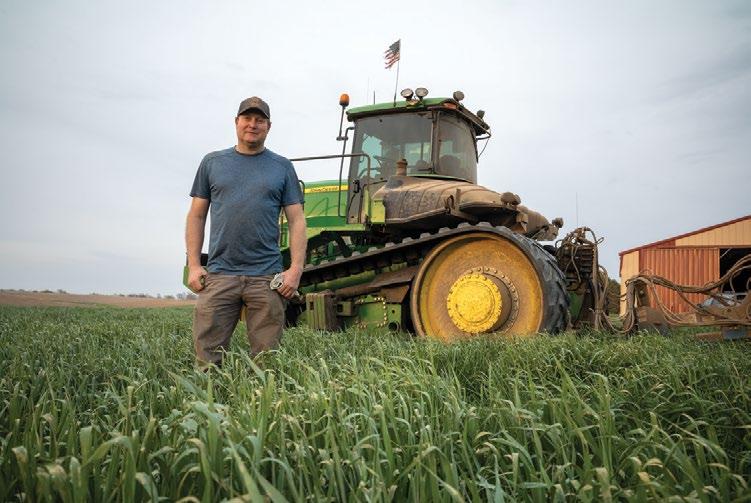

Each state has dedicated on-theground technical advisors to provide research-based information and educational resources to aid in the transition of your field.
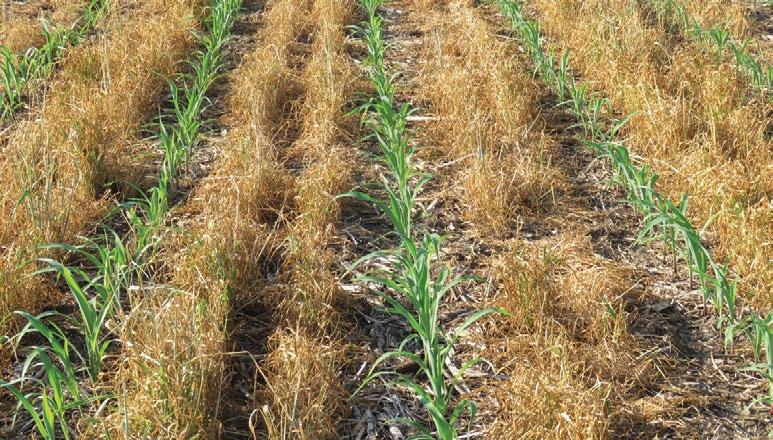
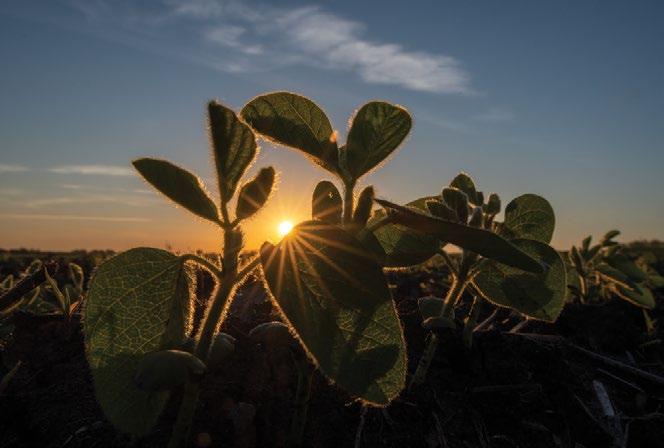
If you’re a homeowner, you have to deal with roof repairs. If you run a brick-and-mortar business, you have to deal with roof repairs. If you have to deal with roof repairs, you need to know about Roof Maxx.
But that’s not where this story begins. This story starts in Gahanna, a community outside Columbus, Ohio, near the homes of O’Shay Mallory and Brandon Gessner. O’Shay and Brandon were buddies in Desales High School. From there, they appeared to part ways. Brandon went on to Otterbein University, and O’Shay to Miami University. Brandon became an entrepreneur in hospitality, while O’Shay joined an accounting firm as a CPA.
But the two remained close, and when opportunity knocked, they listened. They heard about Roof Maxx LLC, a local start-up that now has dealerships nationwide. More specifically, they learned that Roof Maxx opens the door to business ownership through those dealerships. Between O’Shay and Brandon — with expertise in finance, accounting, and entrepreneurship — they had the background for success. Even better, they recognized not only a business opportunity but a chance to provide real benefits to the community and to the environment.
“The Roof Maxx treatment offers a non-toxic and biodegradable substitute for traditional petroleumbased sealants,” says Brandon. “It’s a significant improvement over those sealants, which gum up the shingles and trap moisture inside the roof. Roof Maxx is a win–win–win: better performance at a lower price point, with no harsh chemicals.”
So in 2020, Brandon and O’Shay started Roof Maxx Gahanna.
“Many of our customers are retired homeowners,” says O’Shay. “They’ve been maintaining their homes for a long time. They’re familiar with the costs associated with roof replacement, so they want to get as many years out of their roofs as possible. They know a great option when they see one — and Roof Maxx is a great option.” u

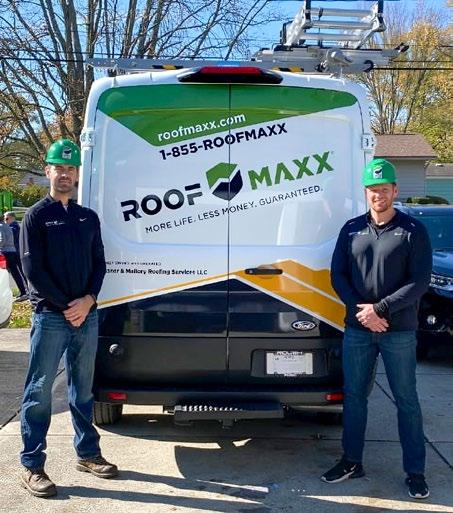
Roof Maxx treatment is an earthfriendly, effective and affordable alternative to roof replacement or the application of traditional roof sealants.
Roof Maxx restores the pliability, flexibility and sun protection of the existing roofing material, without changing the roof’s appearance or trapping moisture inside the roof. Roof Maxx can extend the life of an existing roof up to 5 years with a single treatment (guaranteed) and up to 15 years with repeated treatments.
The formula is soy-based, with no environmentally damaging chemicals, so treatment with Roof Maxx is 100% safe for people, pets, property and the environment.
WISHH leverages partnerships for U.S. Soy to help meet the protein needs of 8 billion consumers
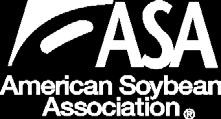
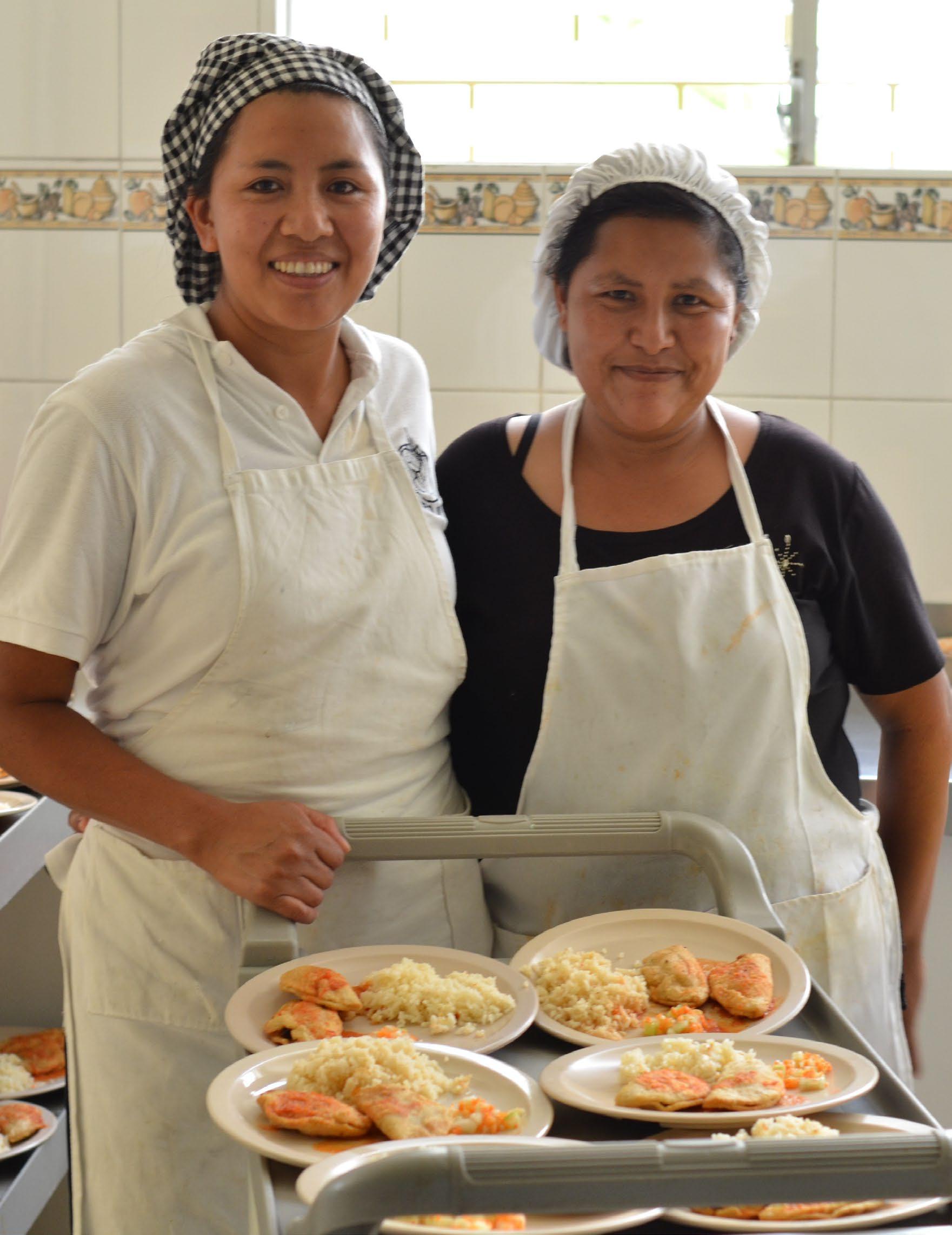

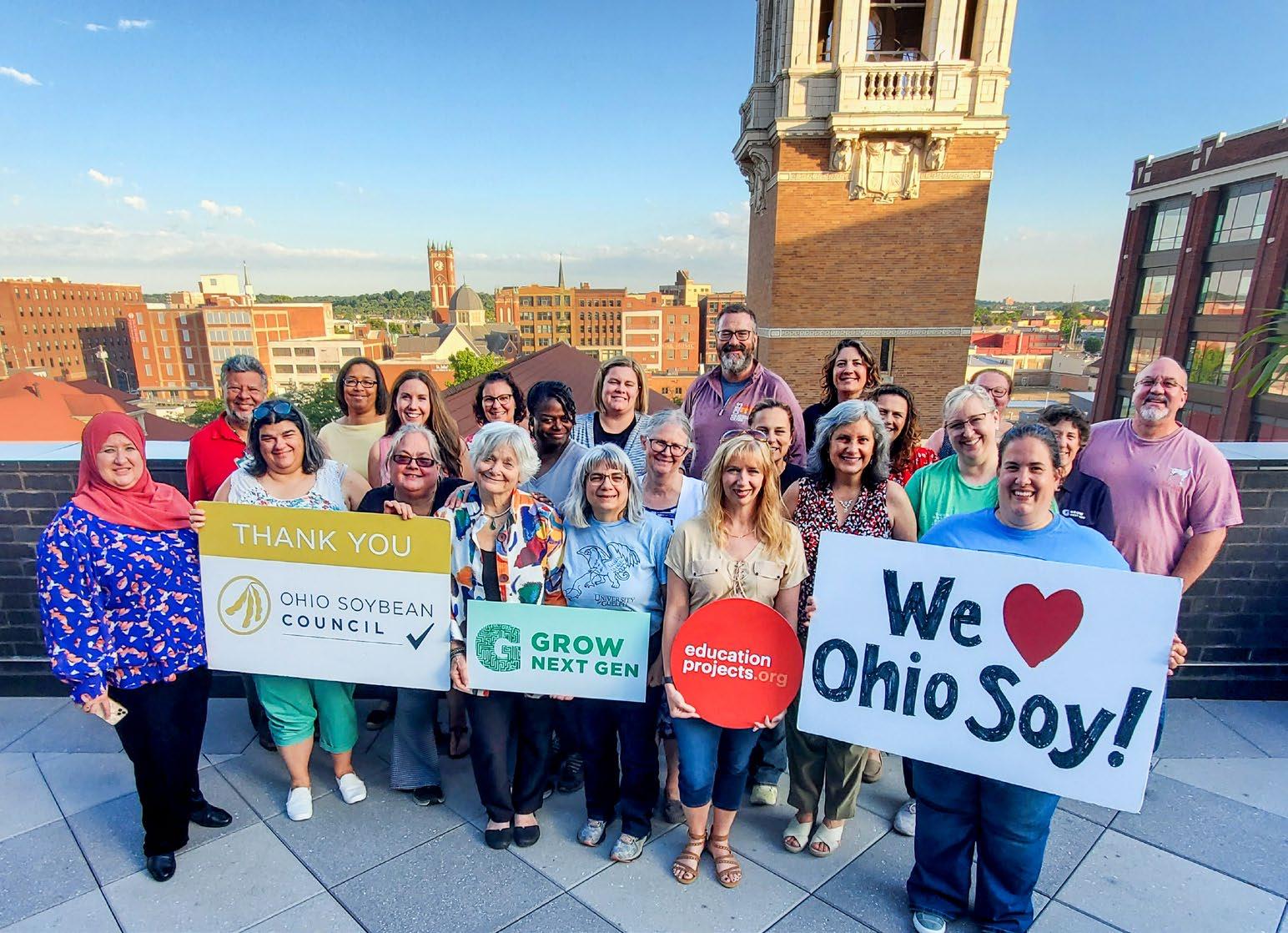
This summer, 28 Ohio science teachers gathered in Dayton for the “Experience Food Science: Field to Package” workshop, part of the GrowNextGen program supported by the Ohio Soybean Council. The two-day event offered educators a close look at the intersection of agriculture, food science and technology. Participants engaged in handson activities, including making soy-based products like chocolate bars, cold foam and ice cream. These exercises demonstrated
the versatility of soybeans while reinforcing scientific concepts taught in classrooms across the state.
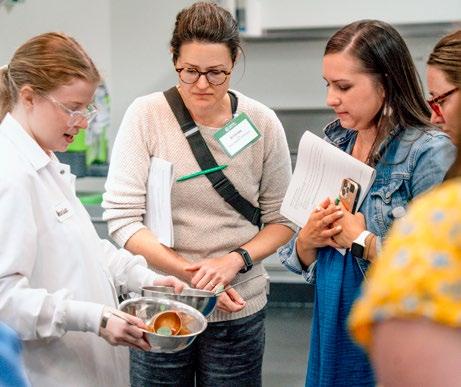
Jessica Kayden, a science teacher from Chaminade-Julienne High School in Dayton, found the workshop eye-opening. “I’ve made ice cream with my students before, but I never thought to use coffee creamer, made with soy. It added an interesting variable to the experiment,” she said. “This workshop has definitely opened up my eyes to careers in agriculture and the food industry.”
The event included a field trip to Dole Fresh Vegetables, providing teachers with insights into largescale food processing. Educators
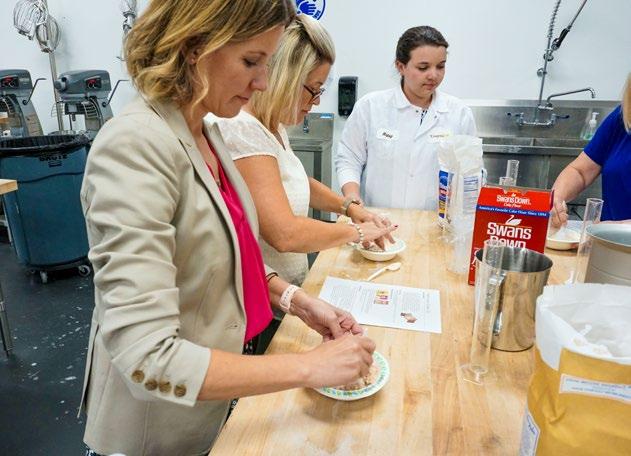
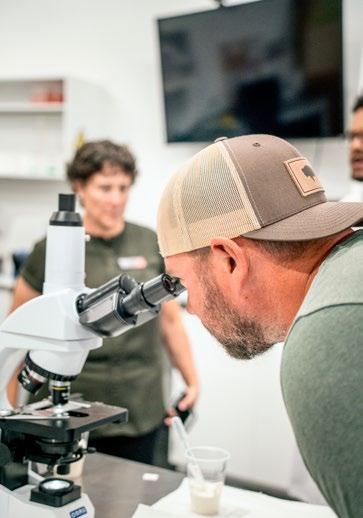
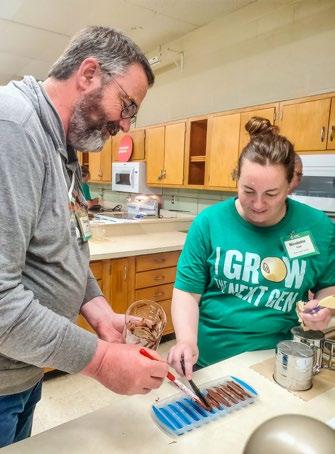
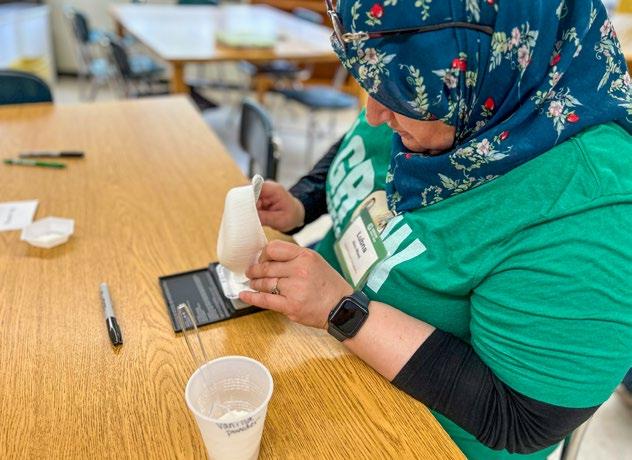
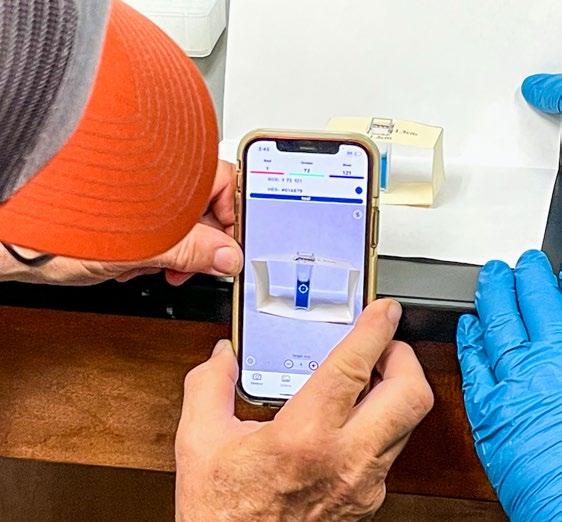
observed the journey of produce from field to package, gaining a deeper understanding of the food industry’s complexity.
Dr. Ella Maria, who teaches 7th, 8th and 9th grade science at Chaminade-Julienne Junior High, plans to incorporate the workshop materials into her curriculum. “I’m going to present the material based on the three branches of science: physical, biological and earth,” she explained. “I’m thinking about planting soybeans in the classroom using different soil types, letting students investigate and explore soy products.”
The workshop also covered crucial aspects of food safety and quality assurance. Teachers learned about pH levels that inhibit microbial growth and the importance of proper sanitation in food processing —knowledge
that applies across various scientific disciplines.
“We’re bridging the gap between textbook science and real-world applications,” explained GrowNextGen Lead Educator Jane Hunt. “These experiences help teachers bring current agricultural practices and food science into their classrooms.”
Each participant received $300 worth of classroom materials to support the implementation of new lessons. An evening dinner with industry professionals allowed teachers to network and discuss current trends in food science and agriculture. The Center for Innovative Food Technology (CIFT) partners with GrowNextGen to provide additional support for the Field to Package experience.
Both Kayden and Maria emphasized the importance of
After the hands-on activities of the workshop, teachers across the state are ready to bring food science into their classrooms.
exposing students to agricultural careers. “It’s important that they know where their food comes from and how it’s made,” Kayden noted.
Dr. Maria added, “I’m planning some field trips because I like taking students to the actual facility, observing the process, looking at the industry standards and talking to professionals.”
The “Experience Food Science” workshop is one of several professional development opportunities offered through GrowNextGen. By providing teachers with resources and knowledge about modern agriculture, the program seeks to enhance science education in Ohio schools while highlighting the importance of the state’s agricultural sector.
“I want to thank the growers, the Ohio Soybean Council and CIFT for this workshop,” Kayden said. “It’s been a great opportunity. I’ve learned so much and connected with some really great teachers and industry experts.”
Maria echoed this sentiment, adding, “This has been wonderful. The experience has been exceptional and has superseded my expectations.” u
As consumers continue to be conscientious about their food choices, a new survey from the United Soybean Board reveals valuable insights into consumer preferences and purchasing attitudes for animal protein, particularly pork products. According to the survey, 70% of respondents say that animal diet is extremely or very important to them when purchasing meat, up from 51% in 2019.
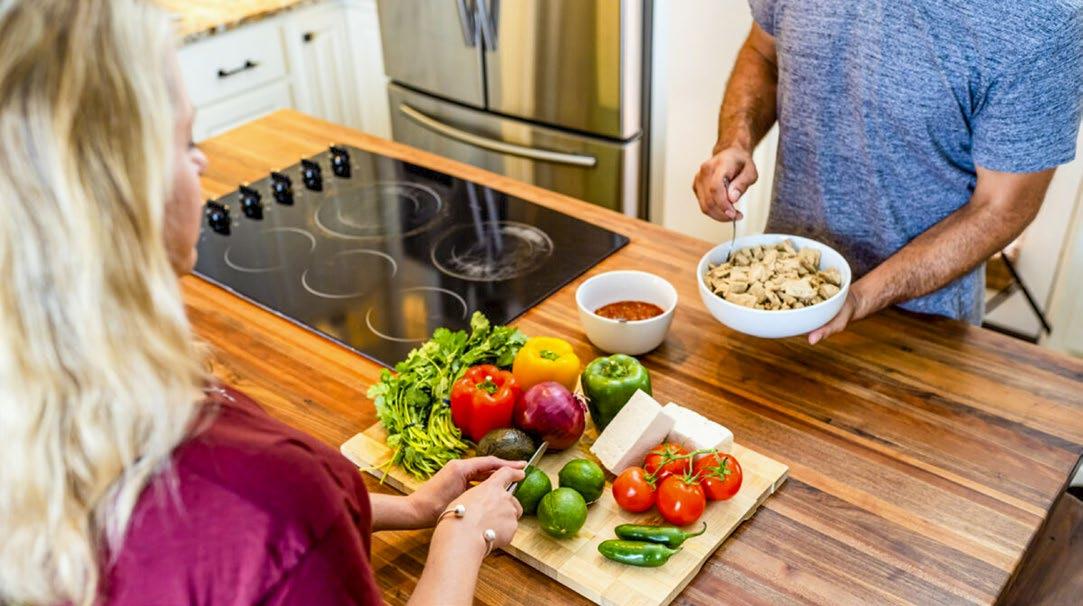
Meat consumers who prefer soy-fed meat say it offers better health, higher quality, greater nutrition and better taste. This research confirms that consumers desire to know more about their meat choices, such as what poultry and livestock consume. When it comes to soybean meal, this nutritional package of protein, the amino acids that make it up, and energy concentration continues to be the standard for all other plant protein feedstuffs.
“It’s no secret that for poultry, livestock and seafood, U.S. soybean meal is an excellent source of nutrients including protein, which is why we grow our own soybeans to feed the pigs on our farm,” said Carla Schultz, checkoff farmer-leader and soybean and pig farmer from Michigan. “Highlighting consumer preference for pork products raised on a high-quality diet presents a real opportunity. Showing that soy is a favored feed ingredient among consumers adds value for our half-million U.S. soybean
farmers,” Schultz shared on a recent Supermarket Perimeter webinar.
Other key takeaways from the survey include:
Consumers are buying pork more regularly, with 41% purchasing pork at least weekly — up from 37% in 2019. Additionally, 30% of millennial meat consumers say they buy pork two to three times a week.
Three out of four consumers (77%) are more likely to purchase meat if it’s raised and fed by U.S. farmers. Even higher than that, the majority of consumers (88%) are more likely to purchase meat from animals born, bred and raised in the U.S.
Nearly all U.S. consumers (96%) pay some attention to food labels. Knowing the animal was raised humanely and fed a nutritious diet are the leading food labels for trustworthy meat brands.
Sixty-five percent (65%) of consumers are more likely to purchase meat if it’s not fed synthetic ingredients, which bodes
well for U.S. soybean meal as a natural ingredient.
Insights from the survey will help inform the checkoff’s communications investments and messaging to key consumers. In September, U.S. Soy and grocery chain Giant Eagle launched a collaboration to promote soy-fed pork to its customers. The checkoff has also partnered with Coborn’s and other large Midwestern retail chains on similar efforts. The goal is to show that consumers seek and may pay more for pork that’s fed sustainably grown U.S. soymeal.
USB commissioned global market research firm Reputation Leaders to survey more than 2,000 U.S. adults online spanning 30% Baby Boomers, 26% Gen X, 31% Millennials and 14% Gen Z. u
At Asgrow® brand, not only are we all about the beans, we’re all about your success as well. That’s why we o er localized products with leading genetics, weed management systems and maximum pro t potential – all developed by soybean experts who put soybeans rst.
DISCOVER HOW IT’S ALL ABOUT THE BEANS. Asgrow.com
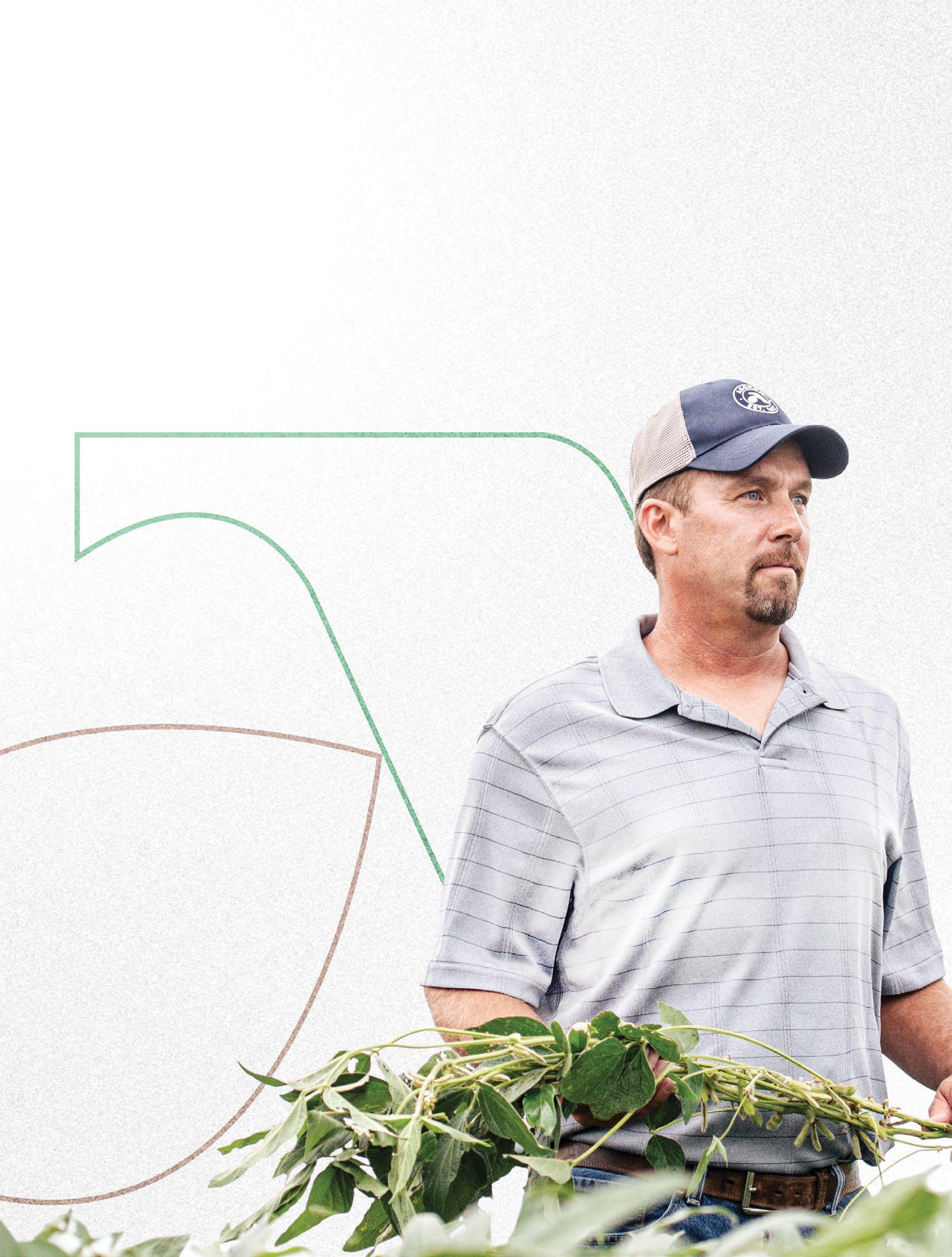

By SNI Global Staff
Lifespans have more than doubled over the past one hundred years, largely due to a reduction in infant mortality and advances in modern medicine. With people living into their 70s (and beyond) the concept of the healthspan has emerged as a measure of the number of years of the lifespan that are “healthy and free from chronic disease.” Optimally, one’s healthspan extends throughout most of one’s lifespan, with physical and cognitive health maintained well into one’s later years.
Unfortunately for many, this is not the case. The Centers for Disease Control (CDC) cites U.S. life expectancy at 77.5 years, and the World Health Organization (WHO) calculates “healthy life expectancy” at 66.1 years meaning there is a 10+ year “gap” between lifespan and healthspan.
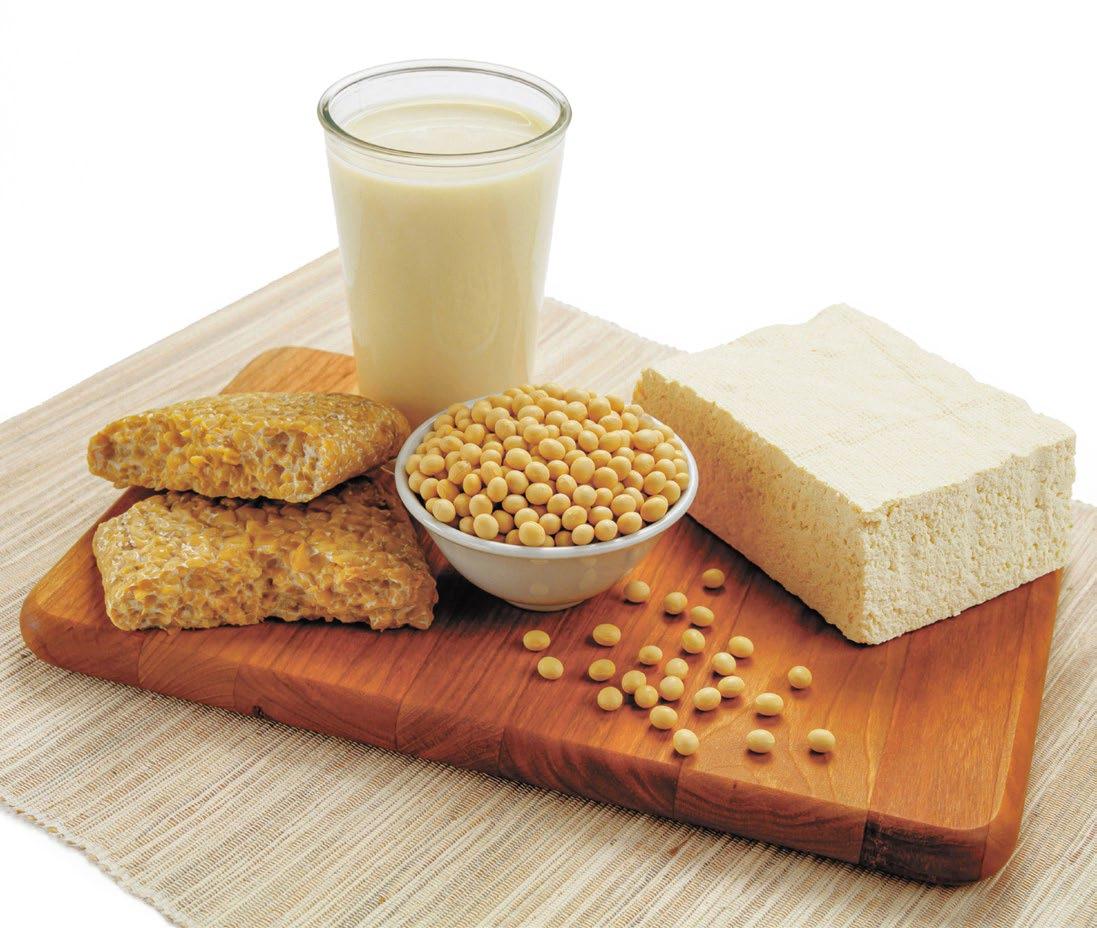
Lifestyle choices, including diet choice, can affect healthspan. As briefly discussed below, intriguing research indicates that the nutrients and bioactives in many soy foods, including high-quality protein, isoflavones and essential fats, may help optimize health into the later years of life.
Muscle mass decreases by 3% to 8% per decade after the age of 30, with declines even higher after age 60. The subsequent loss of strength and function can be a major contributor to disabilities later in life. Resistance exercise combined with dietary protein is key to maintaining and building muscle. The protein found in soy foods is
high-quality and has been shown to promote gains in strength and muscle mass among individuals engaged in resistance exercise training similar to animal protein including whey protein.
More than 1 in 3 American adults struggle with obesity, leading to an estimated $147 billion annually in healthcare-related costs. Dietary protein is increasingly viewed as an important factor in weight loss and weight maintenance strategies, as some evidence suggests protein may promote satiety. The authors of a review of the literature published in the journal Obesity Reviews, concluded that soy promotes weight loss similar to other protein sources. As a result, staying on an energy-restrictive diet that includes satiety-promoting, protein-rich foods including soy foods, may aid in weight loss and maintenance.
Coronary artery disease (CAD) is the leading cause of death in the U.S. Soy protein is the only plant protein that carries a health claim authorized by the Food and Drug Administration (FDA) which states “25 grams of soy protein a day, as part of a diet low in saturated fat and cholesterol, may reduce the risk of heart disease.” Soy protein intake leads to a modest yet clinically relevant reduction in cholesterol. Soybean oil is primarily comprised of hearthealthy polyunsaturated fat. Like soy protein, soybean oil carries an FDA health claim stating, “supportive but not conclusive scientific evidence suggests that eating about 1½ tablespoons (20.5 grams) daily of soybean oil, which
contains unsaturated fat, may reduce the risk of coronary heart disease.” When soy foods replace common protein sources in the U.S. diet, which tend to be higher in saturated fat, there is a favorable shift in fatty acid intake, leading to a reduction in blood cholesterol.
Approximately 10.2 million Americans have osteoporosis and an additional 43.3 million have low bone density. Women face higher risks than men, with osteoporosis affecting nearly 20% of women over age 50. Diet plays a part in osteoporosis prevention, especially getting adequate calcium and vitamin D. While the relationship between protein intake and bone health is complex, studies suggest
bone mineral density (BMD), an important determinant of bone strength, appears to be positively associated with dietary protein intake, but it is unclear if the results depend on the type of protein.
Intriguing research suggests soy foods, likely because they are uniquely rich sources of isoflavones, may promote bone health. Some observational studies have reported that soy intake was associated with a reduced fracture risk among women, and the results of clinical trials indicate soy decreases bone resorption. So, while it is premature to recommend soy foods for bone health solely due to their isoflavone content, soy foods can be recommended for
Eating soy every day is easier than you think with the plethora of great-tasting soy products on the market






those concerned about bone health because they provide protein, and may be fortified with calcium and vitamin D.
Breast cancer is the second most common cancer among U.S. women. Observational studies show higher soy intake is associated with a statistically significant lower incidence of developing breast cancer. Additionally, observational studies show that postdiagnosis soy consumption is linked with a decreased risk of breast cancer recurrence. Numerous health agencies, including the American Cancer Society, have concluded that breast cancer patients can safely consume soy foods. u
Breakfast
▪ Try a soy protein-forti ed breakfast cereal or granola with soymilk.
▪ Swap regular sausage with a meatless sausage patty or have a combination of sausage crumbles and soy. Create a fruit and yogurt parfait layering soy yogurt with fresh fruit and granola.
▪ Whip up a soy protein smoothie with 1 cup of soymilk, frozen fruit, and a scoop of soy protein powder.
▪ Swirl a tablespoon of soy nut butter or soy protein powder into your oatmeal to boost the protein.
Lunch
Enjoy a glass of soymilk or soy protein beverage.
▪ Substitute regular deli meats with meatless deli slices.
▪ Make a grilled cheese sandwich with soy cheese.
▪ Trade regular peanut butter for soy nut butter.
Have a soy veggie burger or hotdog in lieu of a traditional burger or hotdog.
Always have in your desk, or in your bag, a soy protein nutrition bar to stave off hunger in between meals.
▪ Look for nutrient rich bars that have at least 6 grams of protein, contain a good source of ber, and are low in fat and sugar.
▪ Roasted soy nuts or steamed edamame.
▪ Soy nut butter on whole grain crackers.
A glass of soymilk or soy protein beverage. After exercise, choose a protein recovery beverage that includes soy protein.
Dinner
Grill tofu and skewer it with roasted vegetables for easy kabobs.
▪ Substitute soy veggie crumbles in place of ground beef in chili or lasagna, or toss into marinara sauce for a protein boost, or do half ground beef and half
Cube tempeh and toss in soybean (vegetable) oil,
sauce and garlic powder. Roast in a 450 degree oven
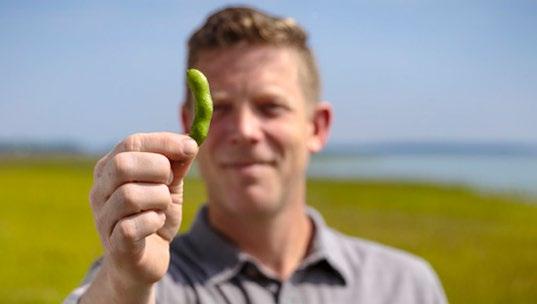
In June, a new documentary funded by the soybean checkoff showcasing the unique innovative power of the soybean, GroundBreaking: A Story of Innovation, premiered on A&E. With an American origin story that dates back nearly 150 years, the soybean plant has evolved into a resource used by farmers, chemists, historians, chefs and astrobiologists. This story features experts diving into how soy unlocks sustainable, biobased alternatives, best-inclass performance, optimized nutrition for animals and humans alike and a viable future to empower space exploration.
“Throughout my travels, I’ve witnessed the infinite opportunities that soybeans can create,” said Jeff Houghton, the documentary’s host. “I’ve been astonished to see the magnitude of where and how soy can show up in the world. Through this story, we uncovered how something so small could have such a huge impact on the planet, from global trade to the food we consume to the clothes that we wear to the cars we drive.”
GroundBreaking: A Story of Innovation, visits nine states and talks to 15 experts about the past, present and future soybeans can create. Those stops include:
Skidway Island, Georgia, where the very first soybeans in America were brought over from China and planted by Samuel Bowen in the 1880s.
The Henry Ford Museum in Dearborn, Michigan, where seeking a crop that could yield great industrial value to him, Henry Ford created a prototype soybean car in 1941 with all of the major exterior body panels made out of soy-based plastic.
Farms in Arkansas and Indiana, where seed innovation enhances sustainability, reduces environmental impact and improves plant health and animal diets.
A Mars simulation at the Mauna Loa volcano in Hawaii, where the Hawaii Space Exploration Analog and Simulation explores soy as a crop that could potentially be used for future Mars missions by planting and researching soy in simulated Martian soil.
the many ways it impacts local economies and communities.”
One acre of soybeans, which equates to about 50 bushels or 3,000 pounds, is enough protein and oil to produce animal feed for 800 pounds of boneless chicken (which could feed 10 people for a year), 50 gallons of renewable diesel fuel (enough for a semitruck to travel from NYC to Pittsburgh) and two years of an average person’s vegetable oil consumption. Continued innovation is creating the potential for the soybean to serve as a catch-all fossil fuel replacement in the near future.

And additional visits to Kansas, Alabama, Pennsylvania and Michigan to explore how soy shows up at the KCBS World Invitational BBQ Contest, aquaculture farming at Auburn University, a Pittsburgh stains and coatings lab and the Detroit Grand Prix.
“As soybean farmers, it’s important to us to get the word out about the amazing bean that we grow,” said Bill Bayliss, Logan County soybean farmer and United Soybean Board member. “I don’t know if many people realize just how versatile our crop is, and
“On top of its many uses on Earth, the soybean’s potential on Mars is something we’re actively researching, due to its ability to grow in microgravity with very limited resources,” said Michaela Musilova, a Slovak astrobiologist currently operating at the Hawaii Space Exploration Analog and Simulation (HI-SEAS). “Soybeans are one of eight crops that could be used during long-duration space missions, and really serves as a Swiss Army knife due to its versatility.” u
To learn more, visit ussoy.org GroundBreaking: A Story of Innovation is now available to stream on the A&E app and aetv.com.
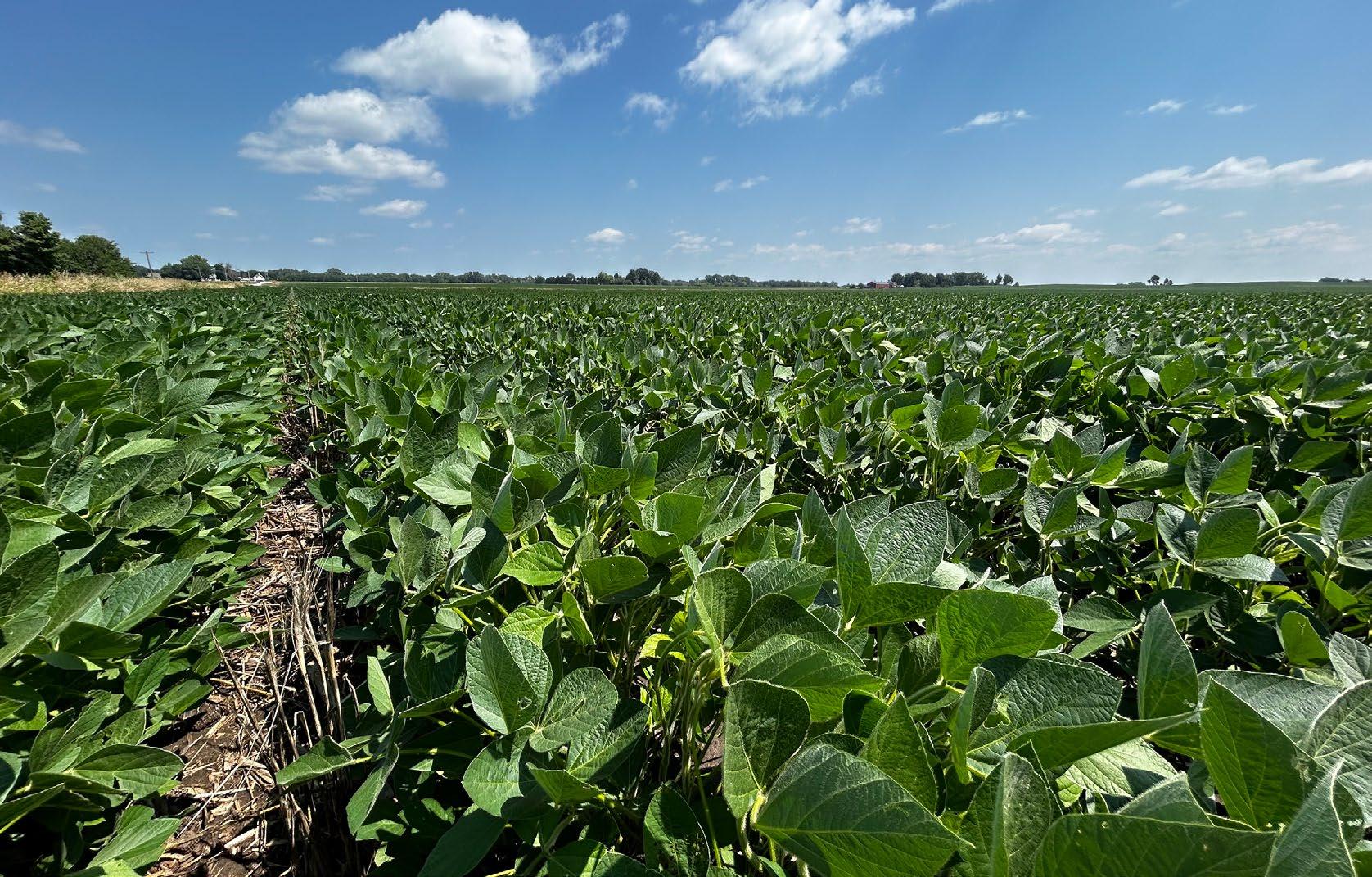
“We’ve been delighted working with your team. It’s just straightforward. With all the cost-share and learning we’ve been able to do, we’ve become more efficient over time.”
- Trent Brass, Illinois farmer
“I would tell anyone on the fence that if you’re leaning toward enrolling in a carbon program, go with the Soil and Water Outcomes Fund because of the team and the support they provide.”
- Adam Peters, Ohio farmer
“It’s been really great to work with you. The first-year contract worked out well. We just got our second payment. We don’t have any complaints about it.”
- Grant Allyn, Indiana farmer

Ingredients
1 1/2 cups Soy Based Wowbutter
1/2 cup unsalted butter, softened
1 teaspoon vanilla extract
1/2 teaspoon salt
3 cups powdered sugar
12 oz semi-sweet chocolate chips
2 tablespoons shortening
Ingredients
2 cups roasted honey-roasted
1/2 cup raw hu seeds
1/2 cup raw pu
1 cup dried app
1 cup dried blu cranberries, or mixture
1/4-1/2 cup dar
Directions
Beat Wowbutter, butter, vanilla, & salt until smooth Gradually add powdered sugar until the mixture holds its shape 1
Form 1-inch balls & freeze for 1 hour 2
Microwave chocolate chips & shortening in 30-sec intervals until smooth 3
Insert a toothpick, dip each ball 3/4 into chocolate, & let excess drip off Place on parchment & remove the toothpick 4
5
Refrigerate until set Store in an airtight container.
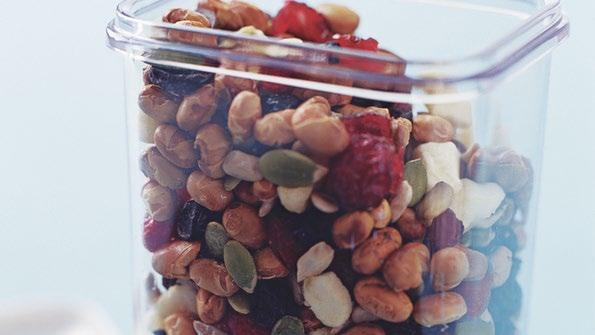
2
Directions
Thoroughly mix all ingredients 1 Store in an airtight container in a cool place.
Ingredients
3 cups old fashioned rolled oats
3 Tbsp light brown sugar
1/2 tsp cinnamon
1/4 tsp salt
1/3 cup honey
1/4 cup soybean oil
1 tsp. vanilla extract
1/2 cup raisins
1/2 cup - 3/4 cup soy butter
Directions
Preheat oven to 300°F 1 Mix oats, brown sugar, cinnamon, & salt in a large bowl 2
In another bowl, combine honey, oil, vanilla, & soy butter Pour over oats & mix until coated 3
Spread oats evenly on a cookie sheet
5.
Bake for 15 minutes, stir, then bake for another 15 minutes until golden brown 4 Cool for 15 minutes. Store in an airtight container
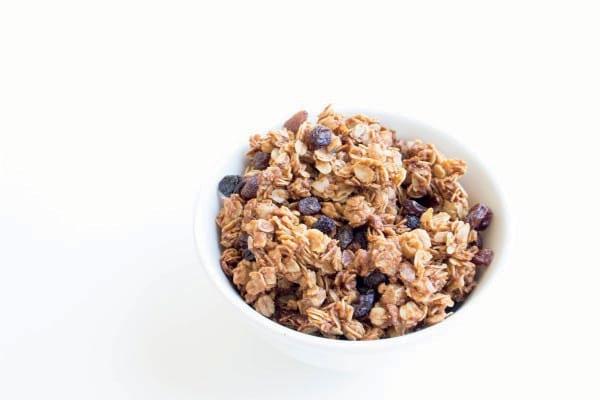
Julia Brown, OSC Director of Communications
Although soybean consumption in human diets makes up a relatively small percentage of the usage of our crop — about 50 percent of the oil and 2.5 percent of the meal is used in food — how people perceive soy foods makes up a large percentage of its reputation. Think of any non-ag person you know. They likely don’t know that the majority of the crop is used to feed livestock. Instead, they associate soy with things like tofu and soy sauce.
A U.S. Soy consumer survey found that nearly 20% of people had negative associations with soy, believing it to be carcinogenic, unhealthy and/or capable of altering hormone levels. These findings are especially concerning when you consider that some of these participants actively avoid soy-based products, especially if those products come into contact with a person’s skin or mouth. The negative perception of soy goes beyond soy foods — it now encompasses products made of soy, like soy-based plastic utensils. Therefore, it is crucial to maintain the reputation of soy foods to ensure the good reputation of our industry as a whole.
new research that breaks down persisting myths about soy foods and demonstrates the considerable benefits of consuming soy foods. Two of their current research projects are being conducted in the Buckeye State.
Dr. Martha Belury heads up the first project, which should be completed by the end of the year,
and regulate metabolism. Belury’s work focuses on that last benefit, including examining soybean oil’s effects on fat accumulation.
Drs. Kenneth Setchell and Marialena Mouzaki at the Cincinnati Children’s Hospital Medical Center are conducting the second study. Their research centers on children with NAFLD

at The Ohio State University. It examines the effects of consuming soybean oil on liver fat and body composition in adults with nonalcoholic fatty liver disease (NAFLD). NAFLD is very common in the United States — 24% of adults are estimated to have it according to the National Institutes of Health.
and how consuming soy milk can impact liver fat severity. Still in its early stages, the study is projected to wrap up in 2026.
SNI Global is helping to do just that. In addition to reviewing and responding to academic papers related to soy in human nutrition, the group also uses soybean checkoff dollars to fund
The study focuses on soybeans’ linoleic acid, which is an omega-6 fatty acid. These acids are fats that the body needs, but can’t produce on its own, meaning they have to come from food or supplements. Omega-6s help stimulate skin and hair growth, maintain bone health, maintain the reproductive system,
These two projects represent only a portion of the important research SNI Global supports. Other current research projects address issues like soy as an allergen and the effect of soy foods on childhood physical and cognitive health. This ongoing research is important to maintain soy’s health reputation on and off the plate.
Interested in learning more about the soy nutrition research funded by your soybean checkoff dollars? Visit sniglobal.org/research. u















No matter what generation farmer you are, the next one is always the most important.













Every farm here was built on generations of hard work. That’s why the Ohio Soybean Council is always hard at work making sure the next generation to operate your farm has every opportunity to make it a better one. Whether we’re driving innovation, expanding markets or educating classrooms — we’re investing in what matters most: creating a solid foundation for the next generation to operate your farm.





